Wondering what to do in Cartagena, Colombia? Visiting Cartagena for the first time? Use our Cartagena travel guide to ensure you experience the best things to do in Cartagena.
Planning to Visit Cartagena, Colombia? Initial Considerations
It used to be that researching what the “top things to do in Cartagena, Colombia” might include has been left to cruise ship excursion decision-makers, if at all. But things are changing: independent Cartagena travel is on the radar!
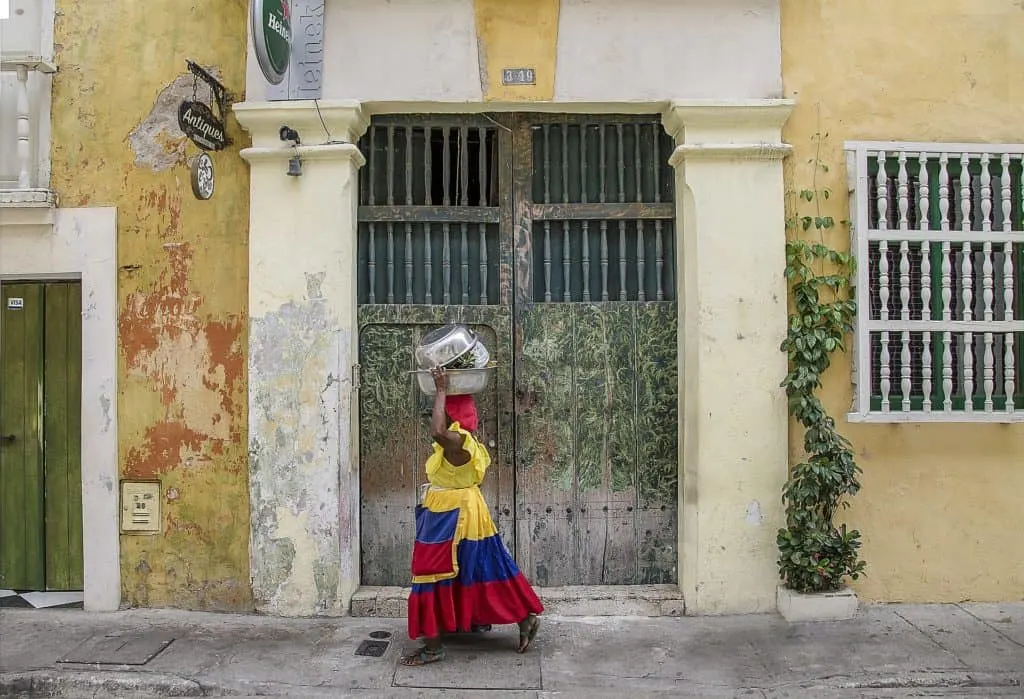
Although in the past several years Cartagena tourism has seemingly exploded, many Americans are now just beginning to consider a visit. Part of this change has to do with pop culture exposure – a recent girls’ trip for the Real Housewives of New York, an episode of the late Anthony Bourdain’s “No Reservations,” and CNN Travel’s declaration that Cartagena is Colombia’s culinary capital, as well as a UNESCO world heritage site.
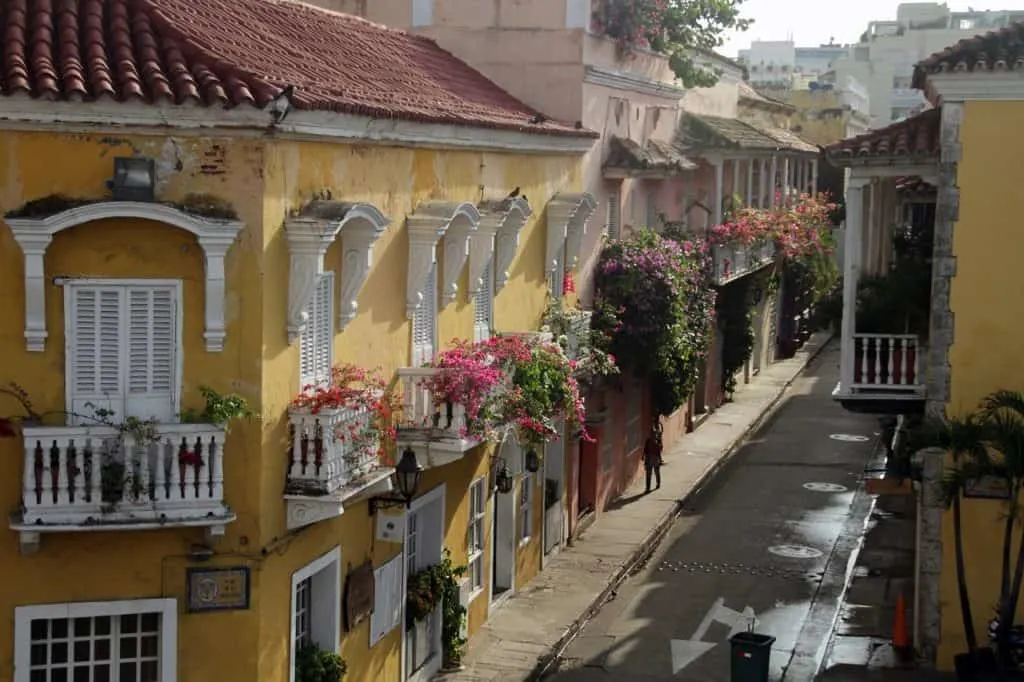
It’s just ludicrous that this exists and everybody doesn’t want to live here. Cartagena is an easy introduction to what’s great about this country. This place is really something special. It’s just going to get bigger and bigger here.
– Anthony Bourdain, Cartagena
We certainly had many of the same feelings when we first considered a Cartagena, Colombia vacation. When we were planning, Cartagena was only one of the must see places in Colombia we put on our itinerary. But, as it turned out, our idyll in South America was the calm before a medical emergency in Colombia turned our life upside down.
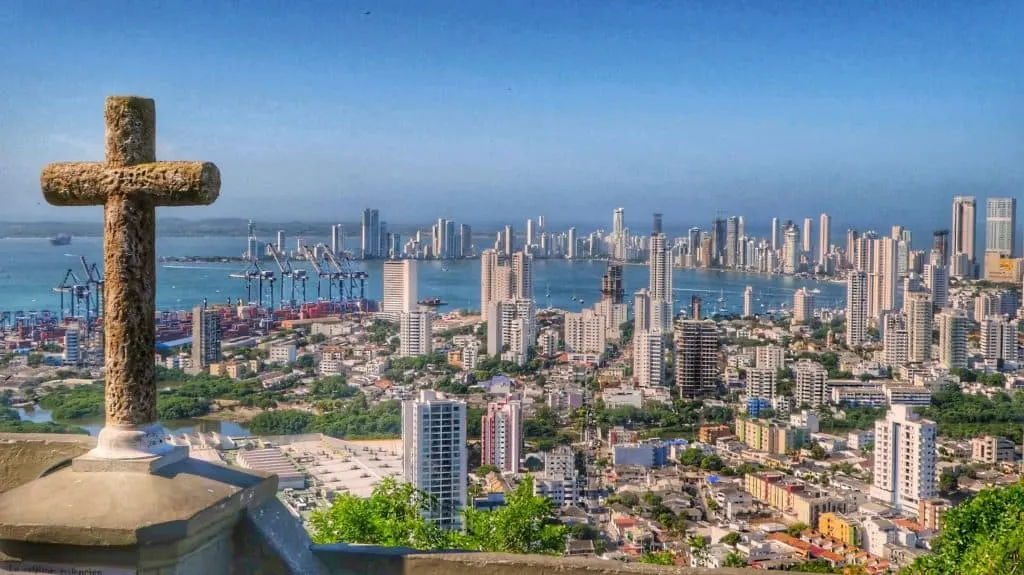
Since then, we’ve told everyone we know they should consider Cartagena, which has some of the best things to do in Colombia for short and longer term visitors alike. If your cruise ship makes a stop in the port of Cartagena, consider yourself lucky. If you’re looking for an alternative to Mexico or a Caribbean island vacation, this is a popular place.
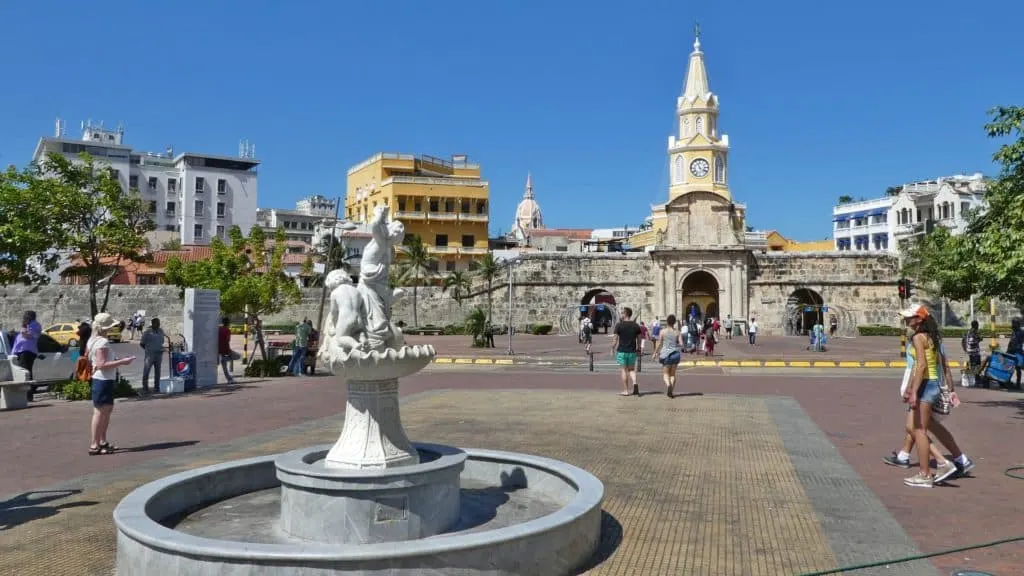
Trips to Cartagena Colombia are quick and easy, with fast flights from Miami and other U.S. airports. Once you arrive, branded and boutique hotels in Cartagena are affordable. Restaurants, beaches and things to do in Cartagena will present a unique blend of cultures – from indigenous to Spanish to African with everything in between.
Included in This Guide: Tips and Recommendations from Travel Blogger Trips to Cartagena Colombia
But don’t just take our word for it. We’ve enlisted recommendations from fellow travel bloggers to enhance those of our own. Use this guidance to plan things to do in Cartagena to create an itinerary that allows you to absorb the magic.
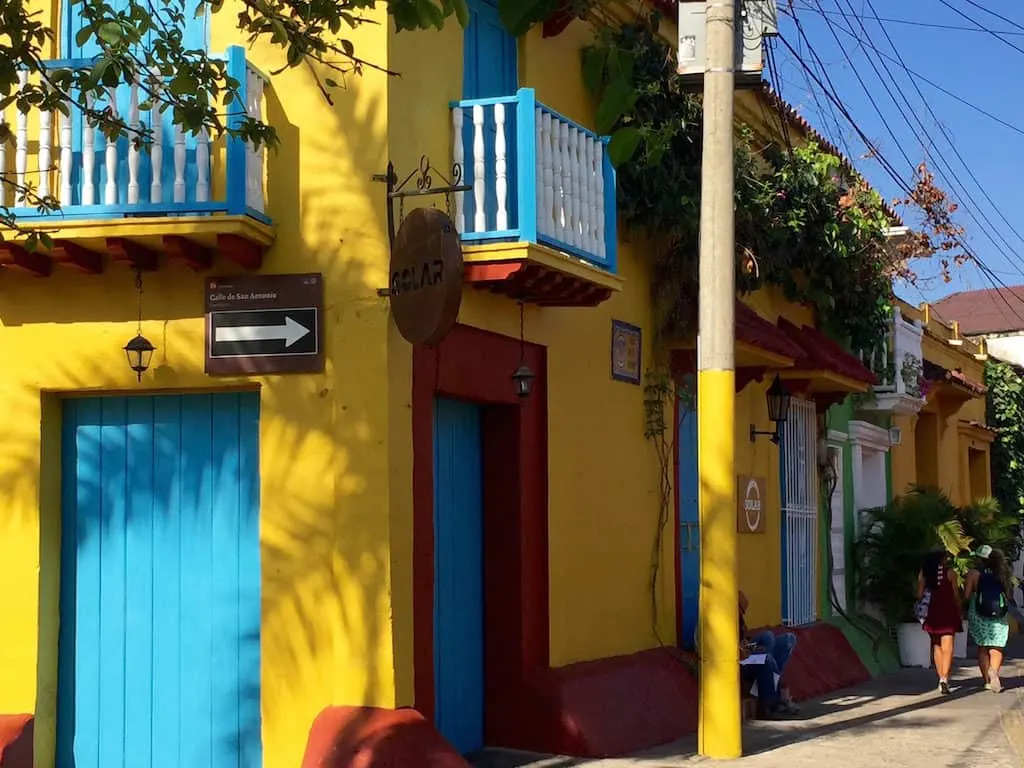
This post contains affiliate links and/or references to our advertisers. We may receive compensation when you click on or make a purchase using these links.
First of All, Where is Cartagena?
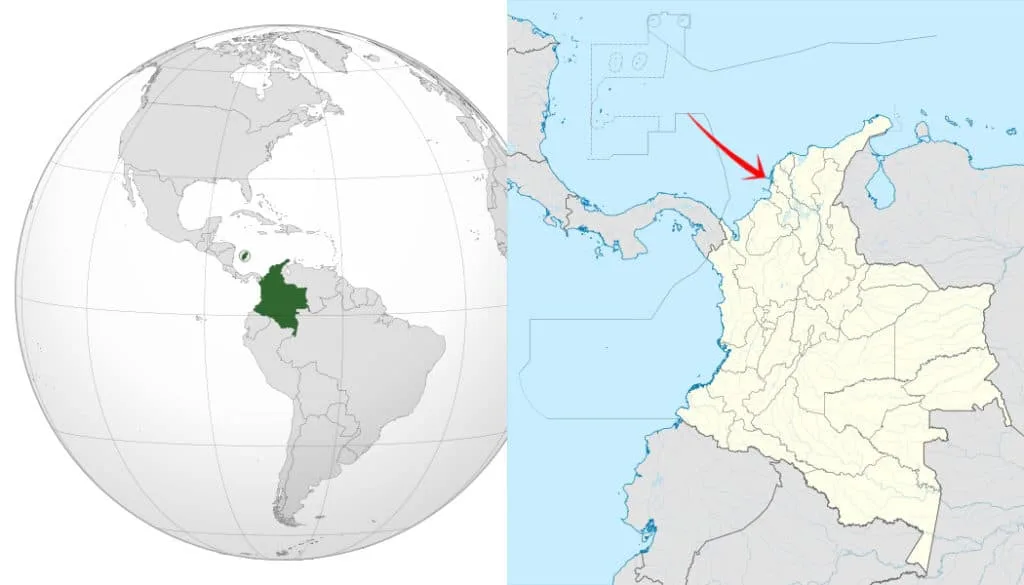
Cartagena is a port city on Colombia’s Caribbean coast. The city lies east of the sea and north of Cartagena Bay, which has two entrances: Bocachica (literally small mouth) and Bocagrande (big mouth). The city is sited between two rivers which were strategically important to Spanish conquistadores, making it a base for colonial exports.
Tip: What time is it in Cartagena Colombia? Colombia Standard Time is equal to GMT-5, varying between U.S. Eastern and Central Time depending upon Daylight Savings Time in the United States.
Is Cartagena Safe?
Many Americans are under the impression that Cartagena and Colombia aren’t safe to visit. This is a holdover opinion based upon sensationalized news accounts of lawlessness during the heyday of drug kingpins. But those impressions are outdated by about 15 years.
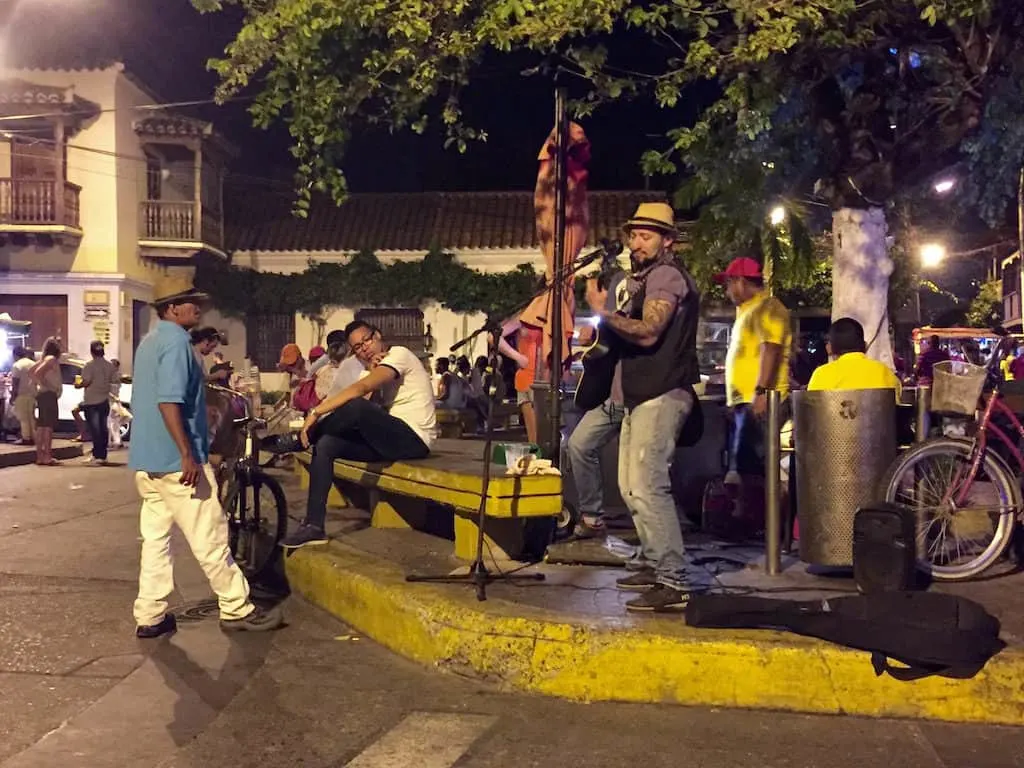
In the interim, Colombia has worked hard to restore its society and standard of living. We felt very safe in Cartagena, even though we stayed in Getsemaní, which is a district where lots of drug traffic formerly occurred. It has undergone a resurgence and is now one of the more popular places to live and visit outside of Old Town Cartagena.

Some potential visitors to Colombia are concerned about what is going on with its neighbor, Venezuela. During our visit, we met several Venezuelans who had relocated and were grateful for the opportunities in Colombia.
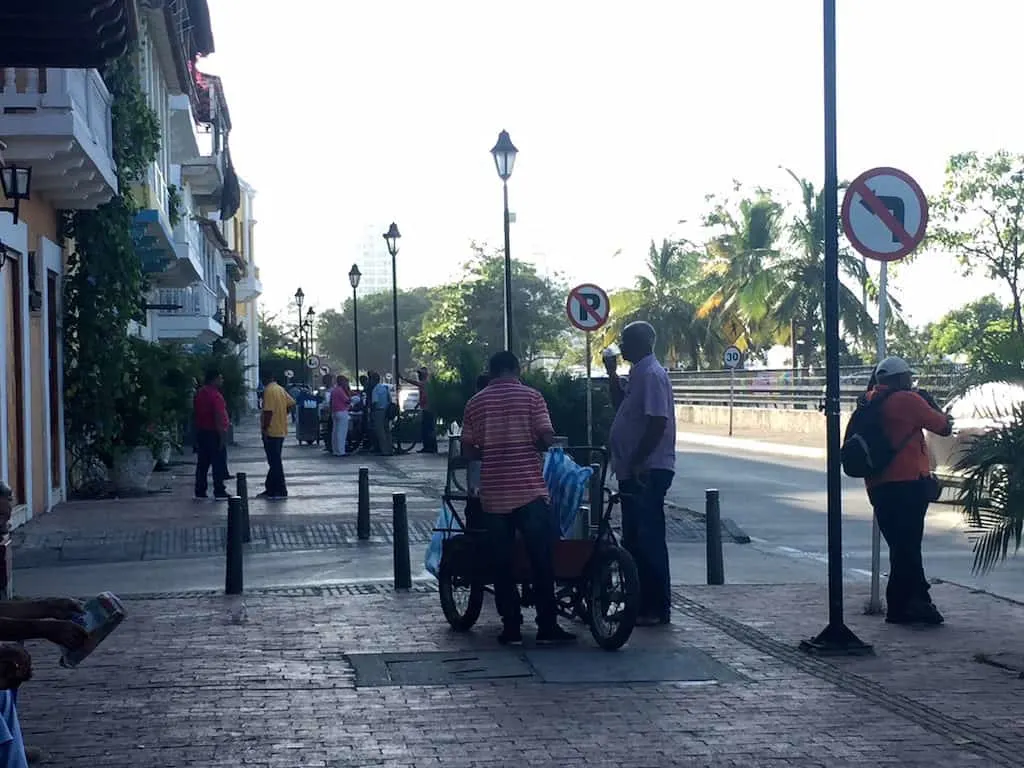
The Colombia-Venezuela border has been closed except for foot traffic for quite some time. As of this writing, Canadian and U.K. authorities recommend visitors stay outside a 50 to 80 km distance from the border. Keep in mind that if you’ve been to Aruba or Curacao, you’ve been closer to Venezuela than you’ll be in Cartagena.
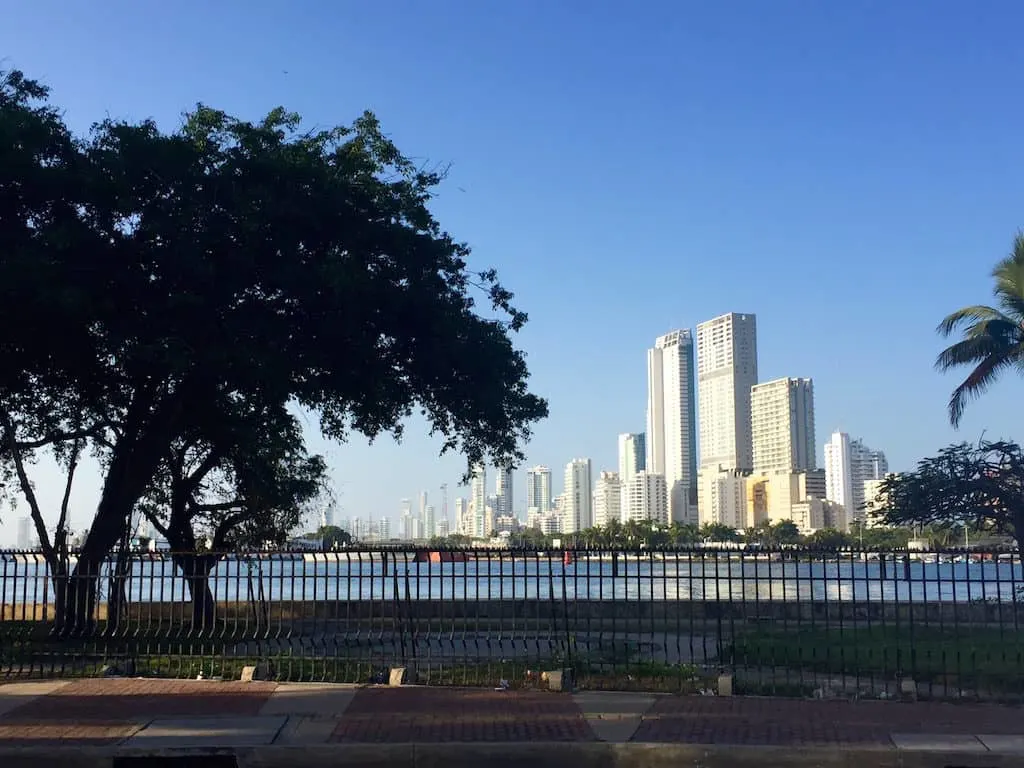
The U.S. State department issues travel advisories for Colombia, and the U.S. Embassy in Colombia informs travelers of potential risks on its website. As of this writing, U.S. government personnel are permitted to travel without restrictions from Cartagena through Barranquilla to Santa Marta along Highway 90, the main coastal artery which leads to Tayrona National Park. Travel by air between major cities is also permitted. What’s good enough for government workers is good enough for us, we say!
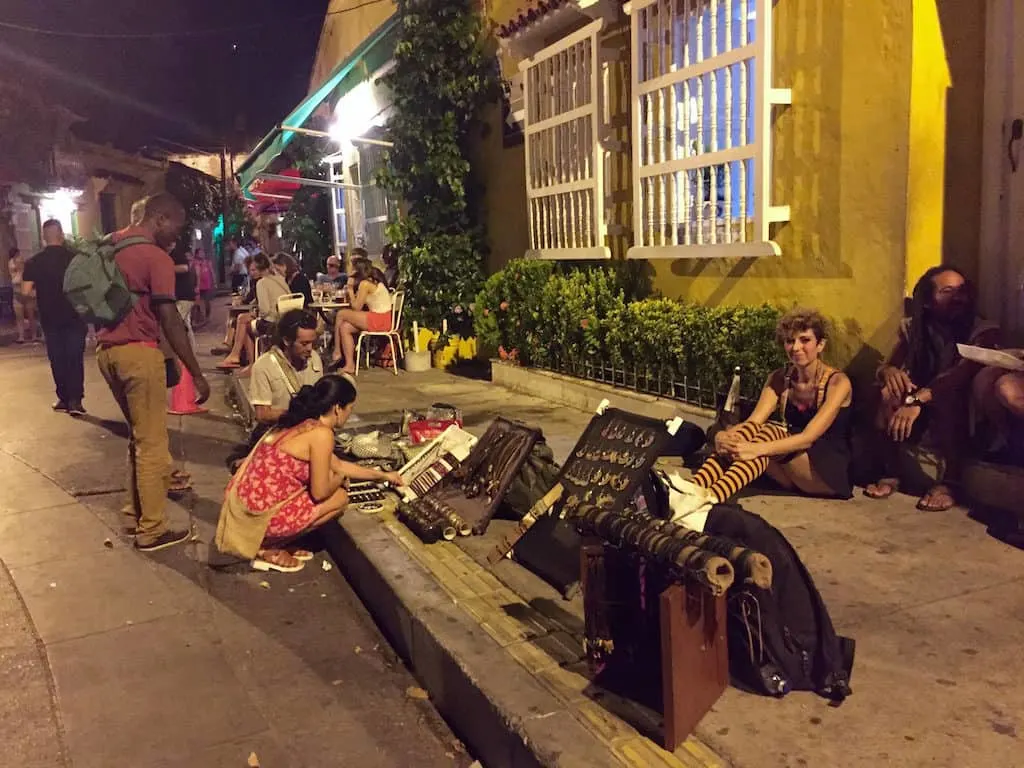
In general, we’d recommend you exercise normal caution as you would in any major city. Because we’re older, we don’t tend to stay out late at night. If you do, stay in well-lit and populated areas. Your hotel concierge can help with transport.
If you’re planning to travel from Bogota to Cartagena, you’ll probably prefer to travel by air. There is a Bogota to Cartagena bus route, but since airfares are reasonable, you might prefer to maximize your time.
When is the Best Time to Visit Cartagena?
The best time to go to Cartagena would be December through April or July through September. This avoids the rainier months of May-June and October-November. The city can be quite windy, especially in the evenings.
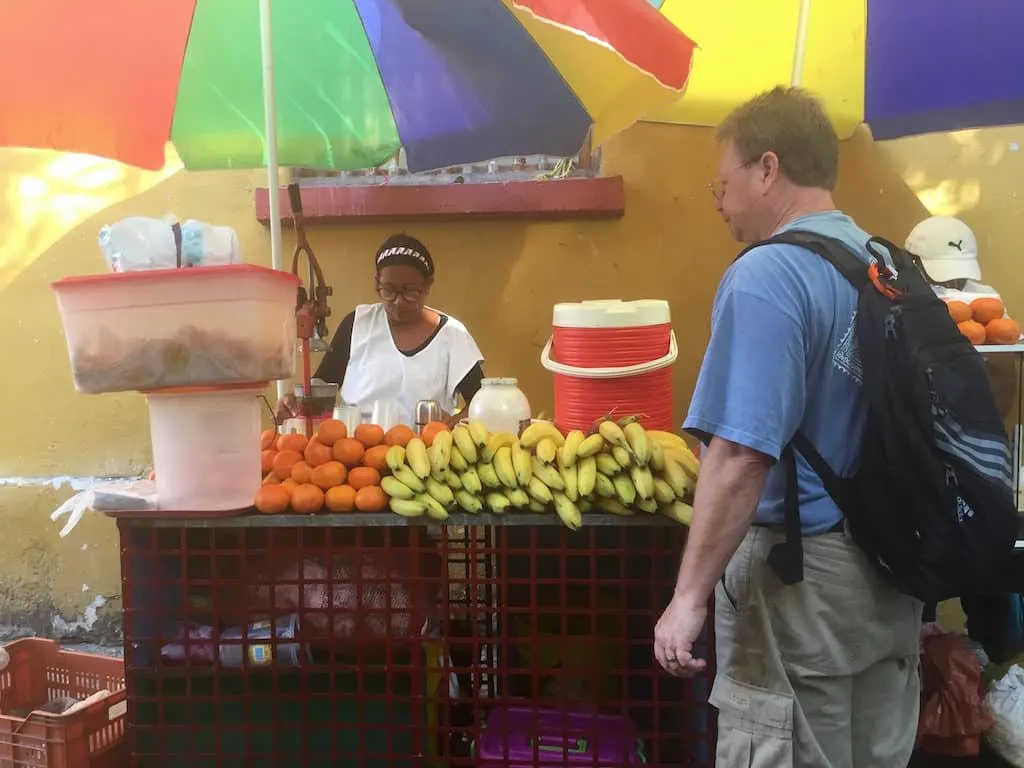
Average high temperatures are between 87-89ºF (30-31ºC) year round. The rainiest month is usually October, with an average of 9.4 inches received. Humidity is high year round as well, usually in the low 80s.
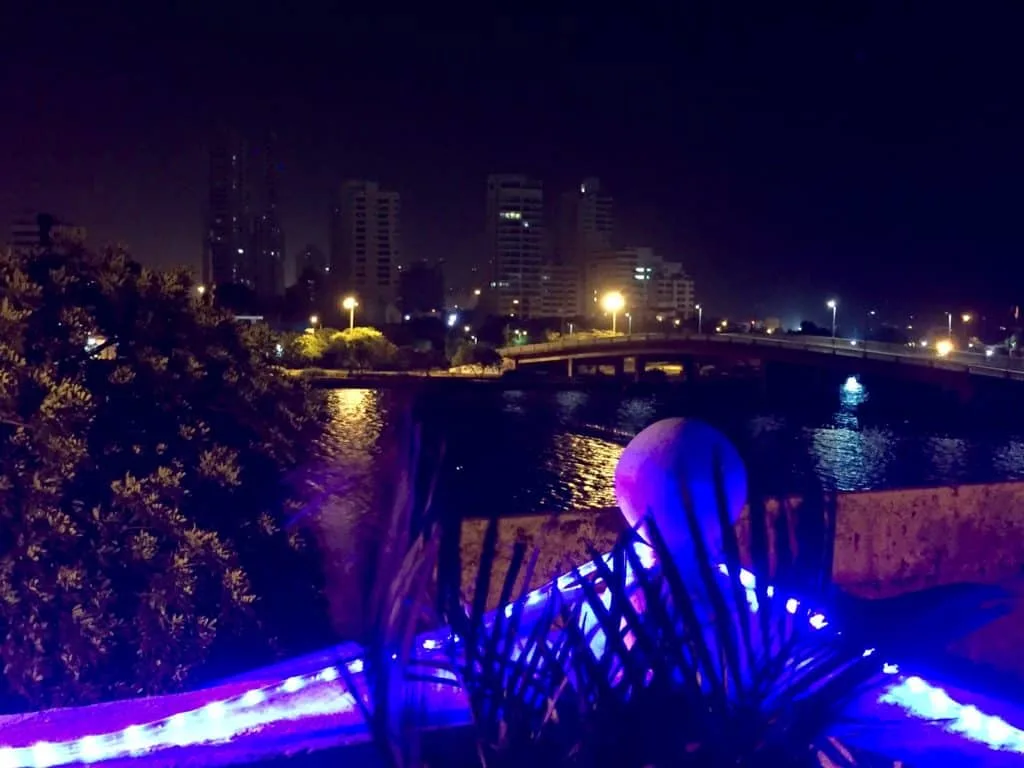
Cartagena: Things to Do to Get Acquainted
For city sightseeing, Cartagena can’t be beat! Cartagena tours inevitably take you through Old Town Cartagena, which dates back to the 1500s and is famous for its colonial architecture. Named Cartagena des Indias by Spanish colonialists, it is important to note this region had been inhabited by various indigenous people going back to 4000 BC. When the Spaniards arrived, several different tribes were present.
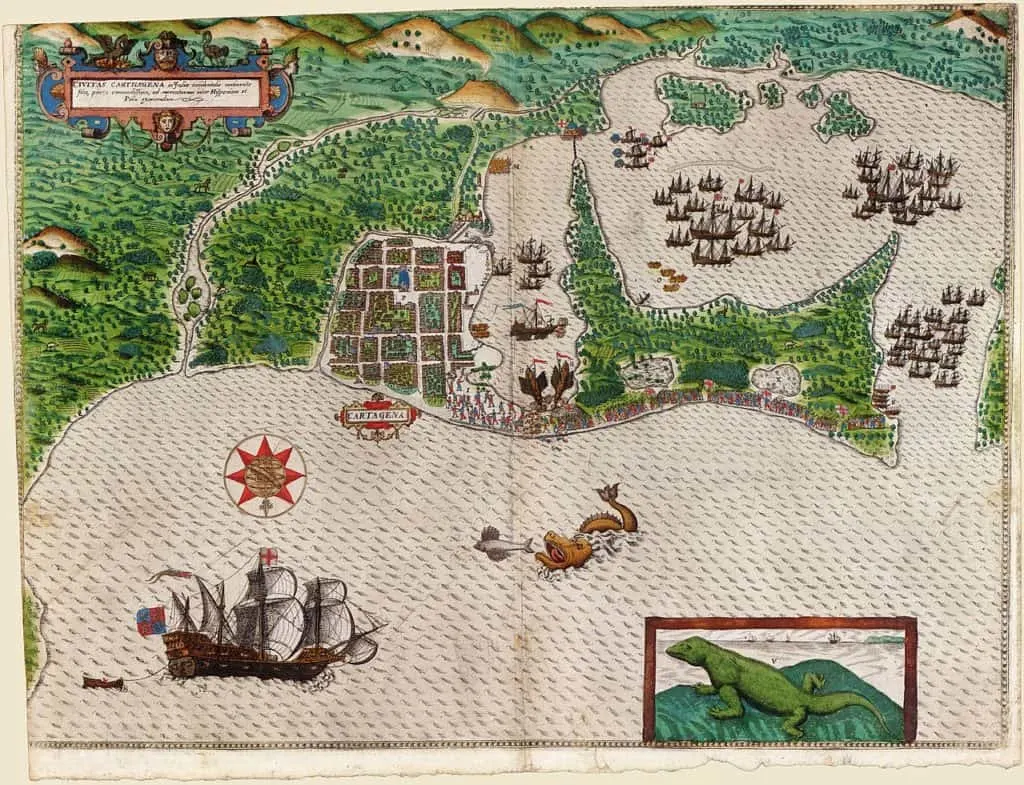
In 1533, the city was founded on the site of an indigenous village and named after a Spanish city in the Murcia province. Cartagena was the main portal for South American silver exports. As such, it was vulnerable.
Tired of paying ransoms to English and French pirates, the city designed and built defensive fortifications in several stages beginning in 1586 after Francis Drake attacked and pillaged it.
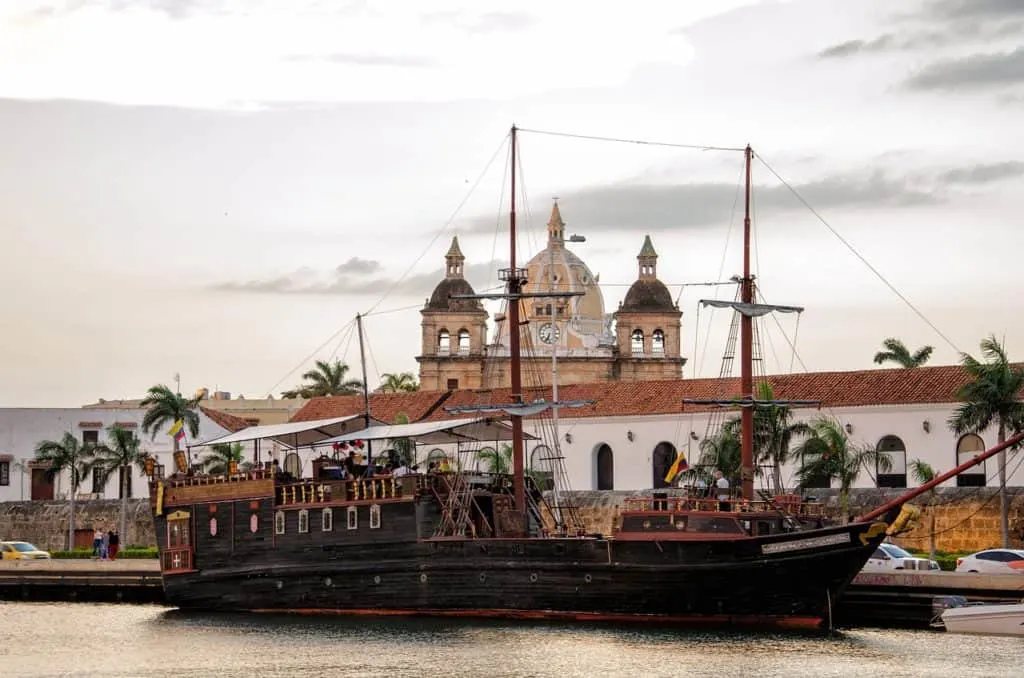
To see and board a replica buccaneer’s galleon, head over to the waterfront quay between the Old City wall and Getsemaní.
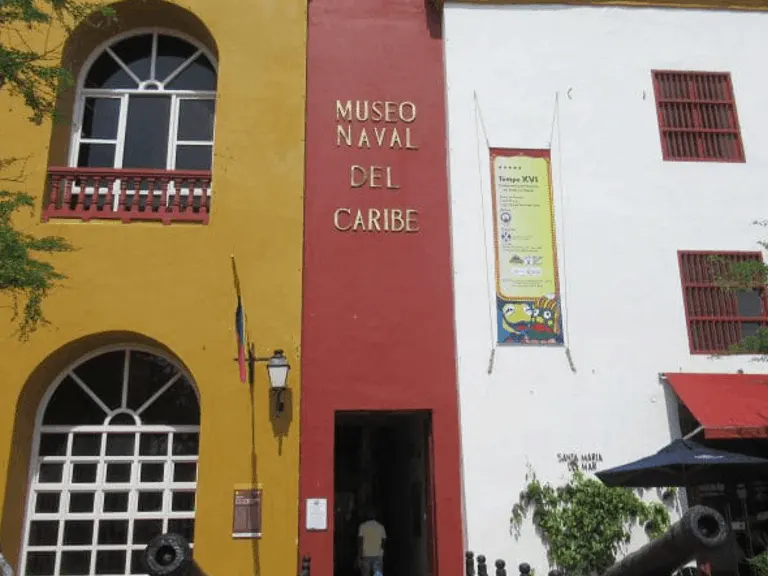
Tip: Visit the Naval Museum – The Museo Naval del Caribe is Cartagena’s absolute best historical museum. Visitors can trace the city’s entire history from pre-colonial times to the present day. As a major center of Spanish colonial trade and power, Cartagena was attacked numerous times by pirates and other European powers. In 1586, Sir Francis Drake looted and burned much of the city. Later another major raid on the city by Edward Vernon was thwarted during the 1741 Battle of Cartagena. The first floor of the museum covers the city’s colonial history, including these attacks. There are some excellent dioramas that trace the events of these attacks as well as some cool models of the city’s many fortifications, including the Castillo San Felipe. On the second floor, visitors will find exhibits on Colombia’s struggle for independence. Cartagena played a leading role. Visitors will also find exhibits on Colombia’s modern naval history, including its role in the Korean War. Finally, there are some great interactive models of a submarine and destroyer bridge that children will love. All of this makes the Museo Naval del Caribe the most complete museum on the city’s fascinating history. That makes it a can’t miss activity for those wanting to learn more about the Cartagena’s history. The museum is located behind the San Pedro Claver Church, near the Hotel Charleston Santa Teresa and is open 9-5 everyday. – Adam McConnaughhay, Cartagena Explorer
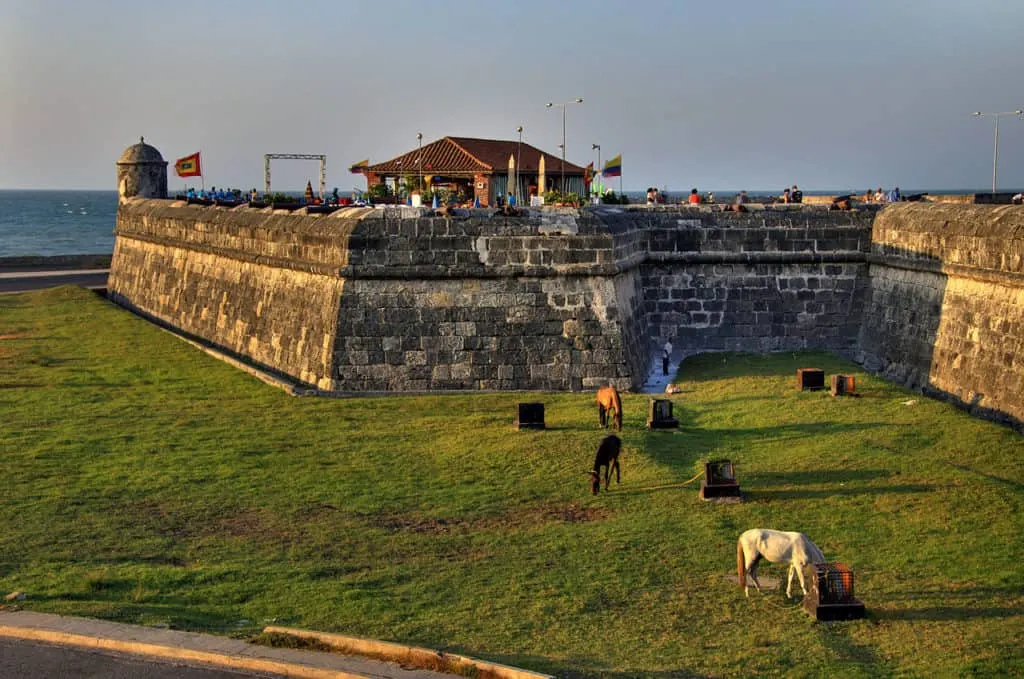
Tip: Enjoy sunset from the wall of the old city. You can’t visit Cartagena without watching the sunset! Start your evening off right at the wall surrounding the Old City. You’ll enjoy a beautiful 360-degree view of the city of Cartagena, the Old City and the sun setting over the Caribbean Sea. Instagram-worthy shots are plentiful. It’s not to be missed. Take in the scene from the infamous Café Del Mar, an open-air lounge and bar located right on the wall. It’s extremely popular for sunset drinks. The café has a lot of space and nice views of the sea and the skyscrapers of Bocagrande. The seats along the wall are prime real estate that are difficult to get without a reservation. You’d probably have better luck getting last minute accommodations in Cartagena! If you do want one of those seats, either arrive super early or make a reservation by calling +57 320 5424502. Café Del Mar has an extensive drink menu and rotating food menu, but the drinks are pricy. Rather than shelling out the big bucks at the café, grab a spot along the public section of the wall. You can literally watch the same exact sunset just a few feet away from Café Del Mar, without paying a penny. You can also enjoy your “free” sunset with a cheap beer from a local (we got two, 24 oz. “tallboys” for 10,000 pesos). Along with other street vendors selling snacks and tchotchkes, they set up shop along the wall with coolers full of drinks. – Brittany McNamara, B Out Exploring
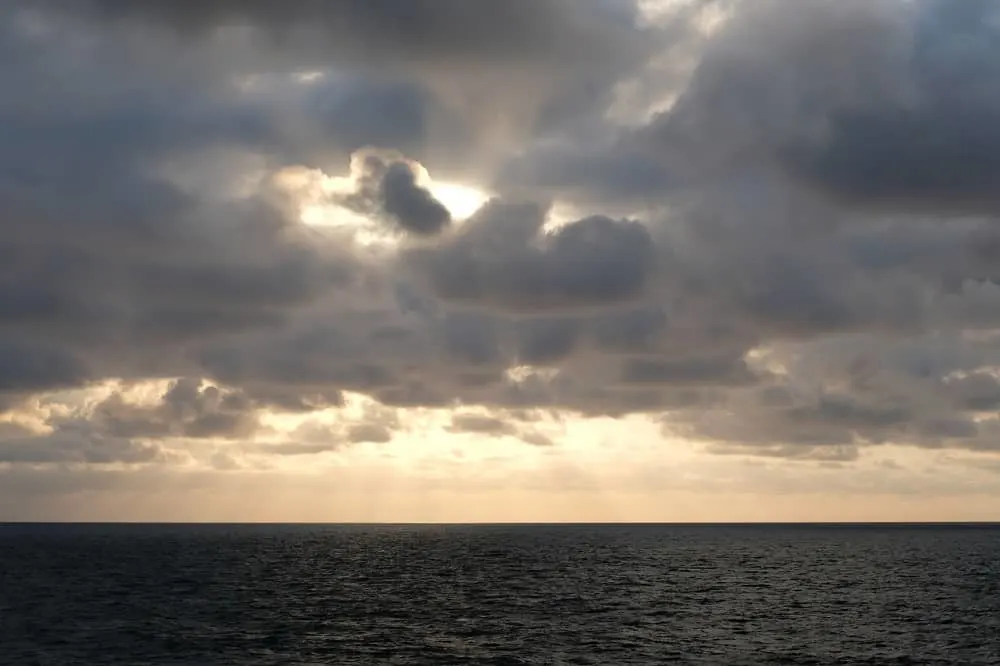
Sightseeing Cartagena with a Tour
One of the best ways to get acquainted with a destination is to take a tour. Fortunately, things to see in Cartagena’s Old Town and Getsemaní neighborhoods lie within comfortable walking distance of each other. You can cover the distance between the most popular Cartagena attractions over the space of a few hours.
Your Cartagena sightseeing tour will likely begin at the Torre de Reloj (Clock Tower), which is the main gate of the Old City. In the 18th century, a moat with drawbridge separated it from the Getsemaní neighborhood.
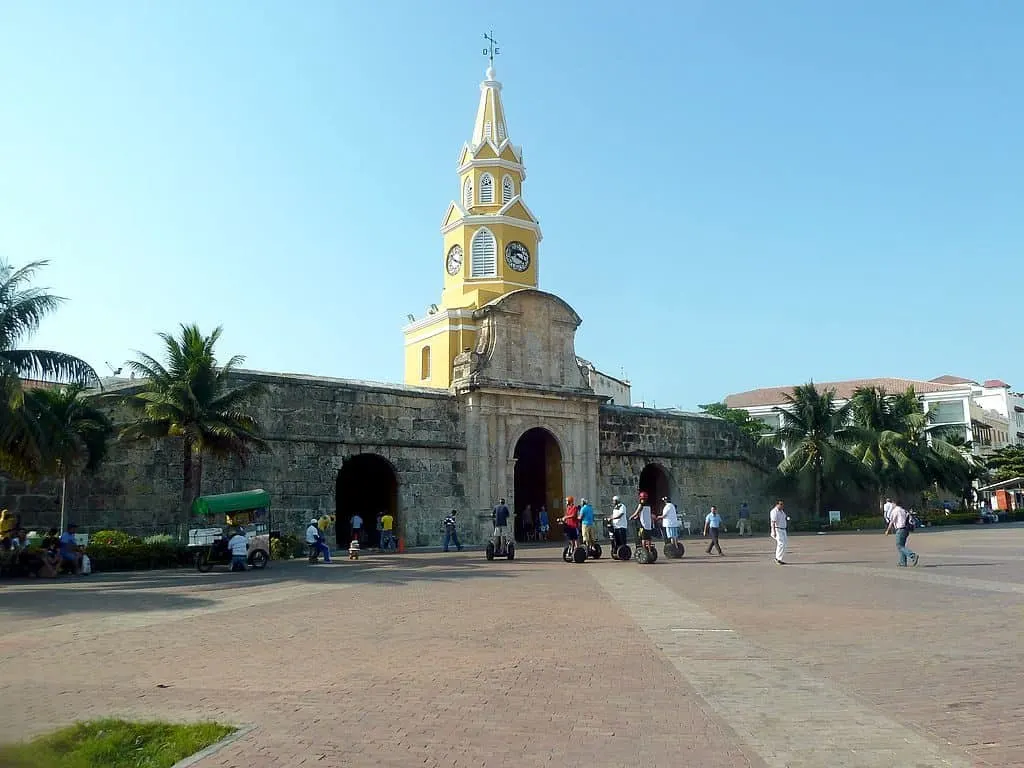
Cartagena 3-Hour Guided City Tour – See Cartagena Bay and a panorama of the Island of Manga in air-conditioned comfort, and visit the walled San Felipe fortress and city center. Click here for more information and pricing.
Cartagena: Old City Guided Walking Tour – A 2 hour walk through colonial architecture and cobblestone streets includes a visit to the Gold Museum’s pre-Colombian artifacts. Click here for more information and pricing.
Cartagena: Rosario Islands Catamaran with Lunch and Snorkel (best seller) – Sail aboard a luxury catamaran to the Rosario and San Bernardo Corals National Natural Park. Snorkel off a pristine sugar sand beach in crystal clear water; enjoy a delicious shore lunch under sail. Click here for more information and pricing.
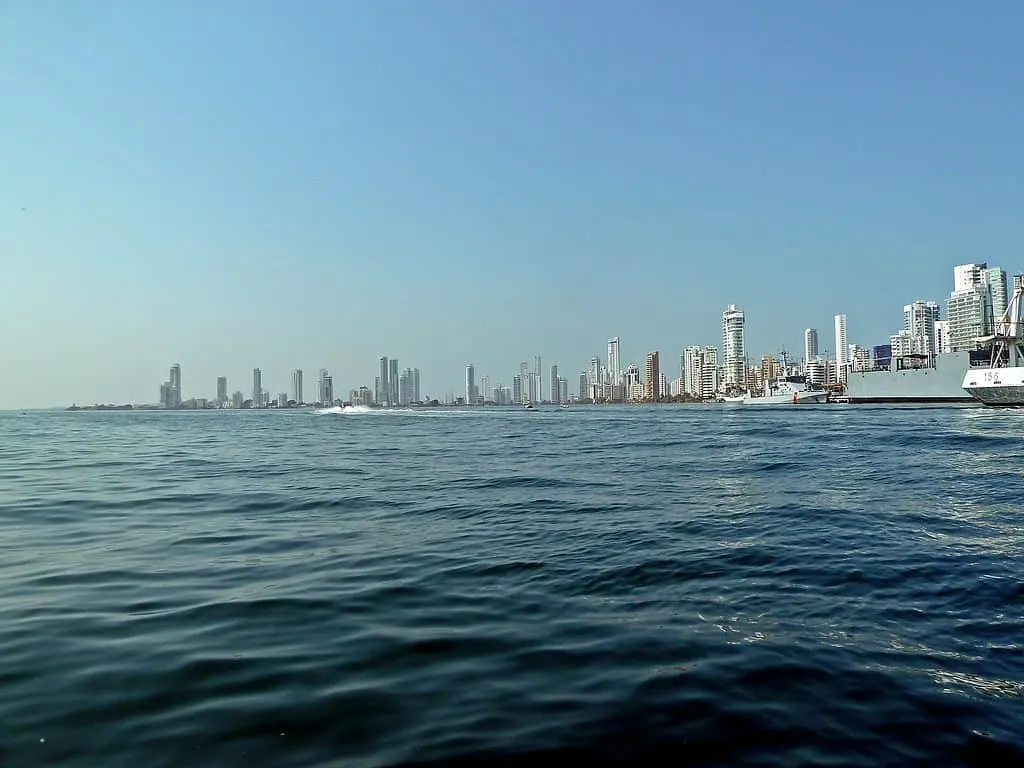
Feel like cruising Cartagena Bay with a variety of dinner options? Click here.
Cartagena’s Dark History
Most tours in Cartagena’s Old Town will feature the Plaza Bolivar, which was the city’s main plaza in the old city. It was here that sentences of the condemned were read during the Spanish Inquisition, which lasted for two hundred years beginning in 1611. More than 700 people were executed for heresy, witchcraft, and other crimes during that time.
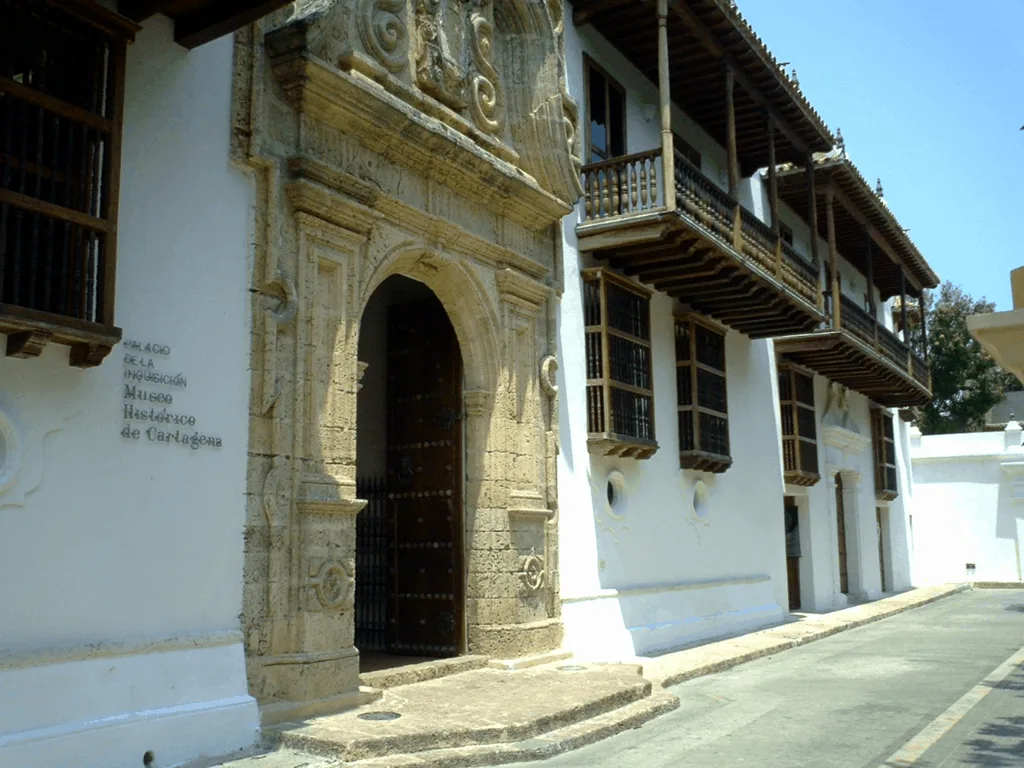
Concurrently, European slave traders brought Africans to the New World, participating in the Spanish asiento system, which was devised to regulate and profit from their importation.
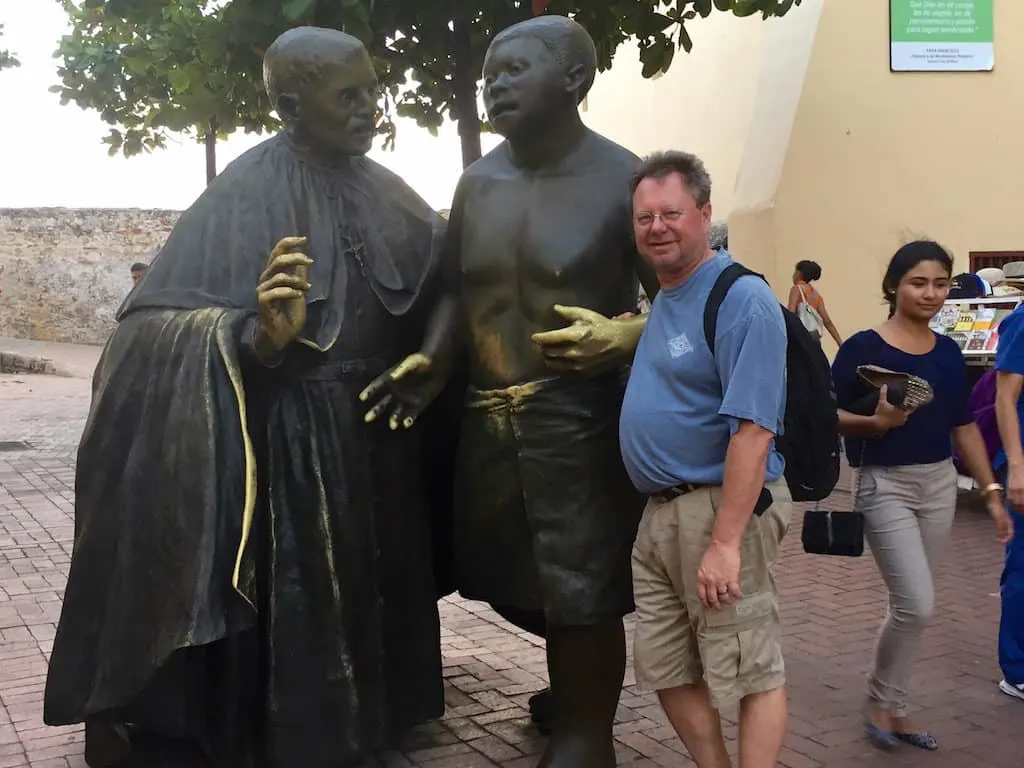
Tip: Visit the Church of San Pedro Claver. – The Church of San Pedro Claver is arguably the most beautiful church in all of Cartagena, boasting an intricately carved stone façade that belongs to the Jesuitic style. But even more than its beauty, it deserves to be visited for its poignant history and its role in the human rights movement. The church and the adjacent monastery and museum are named after a monk who was born in Spain but lived in the monastery for almost 40 years and eventually died there in 1654. San Pedro Claver dedicated his life to defending and protecting African slaves brought to Cartagena. And also converting them to Christianity, of course. When visiting the monastery, you can see the well in the cloister where Pedro Claver baptized tens of thousands of black slaves. He was known as the “Saint of the Slaves” and the “Black Man’s Apostle”. The Italian marble high altar at the front of the church serves as the resting place for the monk’s mortal remains. Much of the monastery has been converted into a museum, with exhibits that include pre-Colombian ceramics, religious art, and even contemporary Afro-Caribbean paintings and masks. The monastery cell where Pedro Claver lived and died is also open to visitors. A statue of the monk, which is the work of the artist Enrique Grau, stands in the square in front of the church. – Wendy Werneth, The Nomadic Vegan
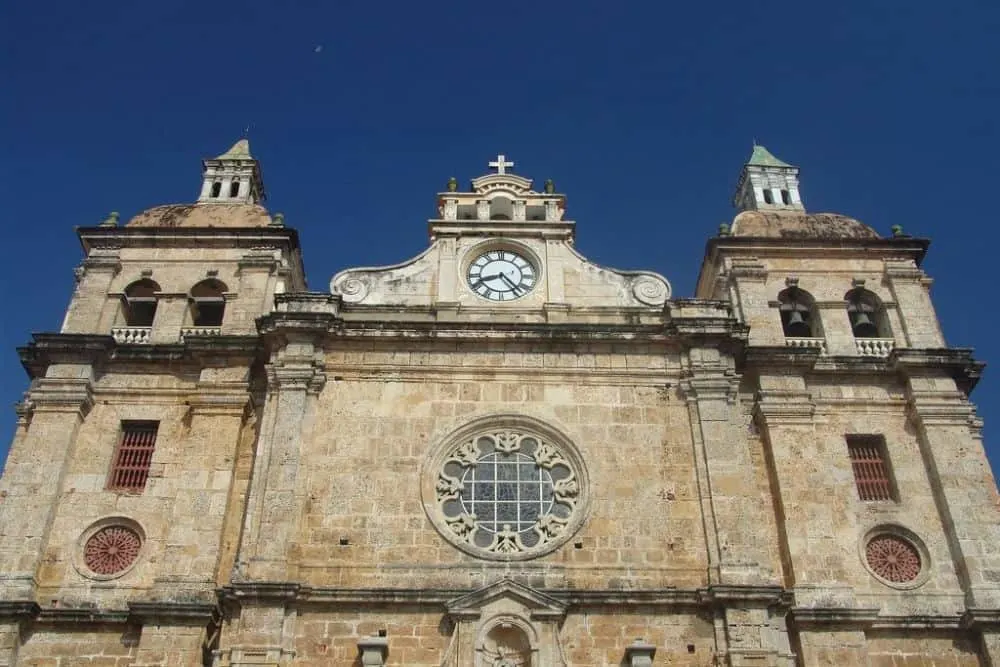
Tip: Visit Castillo San Felipe de Barajas – Castillo San Felipe de Barajas is a fort that was built already in the 16th century, and later expanded in the 17th century during the colonial era. It has a strategic location on top of the Hill of San Lázaro. The fortress is built in stone and was listed as a World Heritage Site by UNESCO in 1984. If you’re a history buff, this is definitely something to write down on your list of things to do in Cartagena. The tropical surroundings with palm trees and greenery also makes it easy to imagine what it was like during the colonial era. The main reason why they built the fortress was to defend the treasures of gold, silver, cacao, tobacco and chilli. Piracy was highly frequent in the region, and historians believed that before Castillo San Felipe de Barajas was built, Cartagena was one of the most looted port cities in the New World. Today, it’s a lot less gruesome, and the fortress is one of the top places to visit in Cartagena. Daily currency exchange will affect your entrance fee, which is about 7-8 dollars depending. In Colombian pesos you pay 25.000. The castle is open from Monday to Sunday from 8 a.m. to 6 p.m. – Alexander Waltner, Swedish Nomad
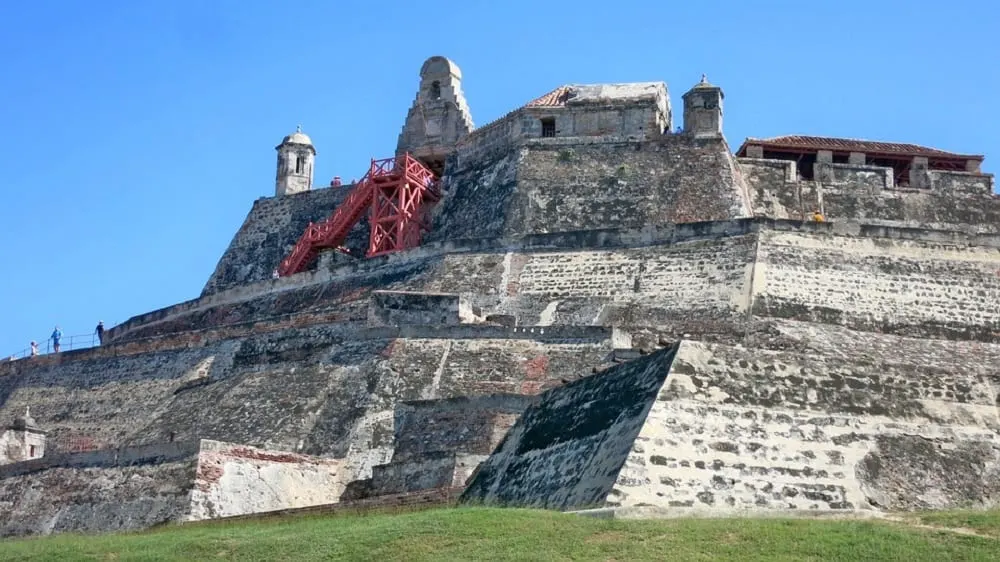
Tip: Bike Tours – For a relaxed yet insightful look into life in Cartagena consider a bike tour. The owner of the tour company we used, Gerardo Nieto, is a native “Cartagenero” celeb! This cyclist has enjoyed an entertaining past as film director. A role that runs in his family. There are two tours to choose from, one is movie related and the other is a beach Cartagena tour. During the movie bike tour, you pedal to filming locations as well as past and through historically important attractions. The Manzanillo del Mar tour does what it says on the tin! This tour heads to the northern suburbs through fishing villages and to Manzanillo del Mar. These bike tours are a great option for those who want to stretch their legs without exerting too much energy (you’ll need that for the sunset cocktails!) – Gemma Armit, Two Scots Abroad
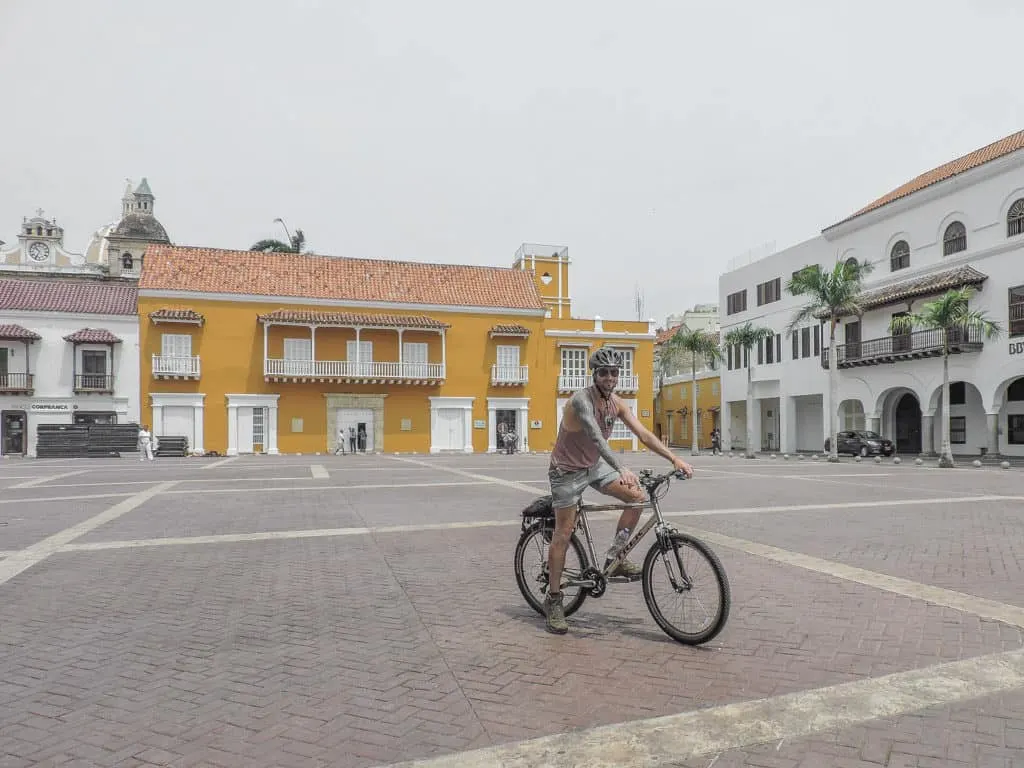
For information on a free bike tour of Cartagena (you just pay for the bike rental), click here.
Appreciate the Natural World In and Around Cartagena
Take a Day Trip to the Rosario Islands – Bret Love & Mary Gabbett of Green Global Travel. Located just a 45-minute boat ride away from the rich history, bustling nightlife, and thriving culture of Cartagena, this little-known ecotourism haven is an outstanding archipelago comprised of 30 different islands and islets. The Rosario Islands have some of the most beautiful beaches in Cartagena.
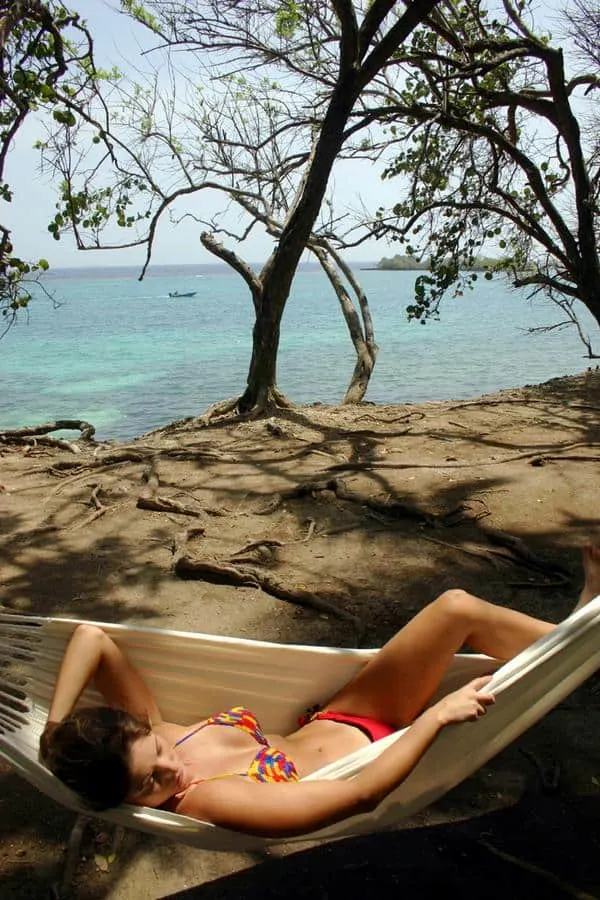
These islands are all part of Colombia’s Corales Islas del Rosario Natural National Park, which protects approximately 4,633 square miles of reefs, sea grass, and mangroves (and the aquatic species that inhabit them). As you might expect, the snorkeling and scuba diving in the Rosario Islands are superb, with marine life ranging from colorful coral reefs and tropical fish to lobsters, spotted rays, invasive lion fish, and more.
But like all the best Caribbean islands, you can have an equally excellent time just lazing the day away, curling up in a hammock with a stiff drink, and then watching the spectacular sunset over the sea.
If you want to spend the night in the area, the Coralina Island Hotel is a peaceful, foodie-friendly paradise that offers a great mixture of elegant sophistication and laid-back simplicity.
Playa Blanca – Nicole LaBarge. Playa Blanca is one of the most famous beaches in Colombia. And for good reason – beautiful turquoise waters and golden sands.
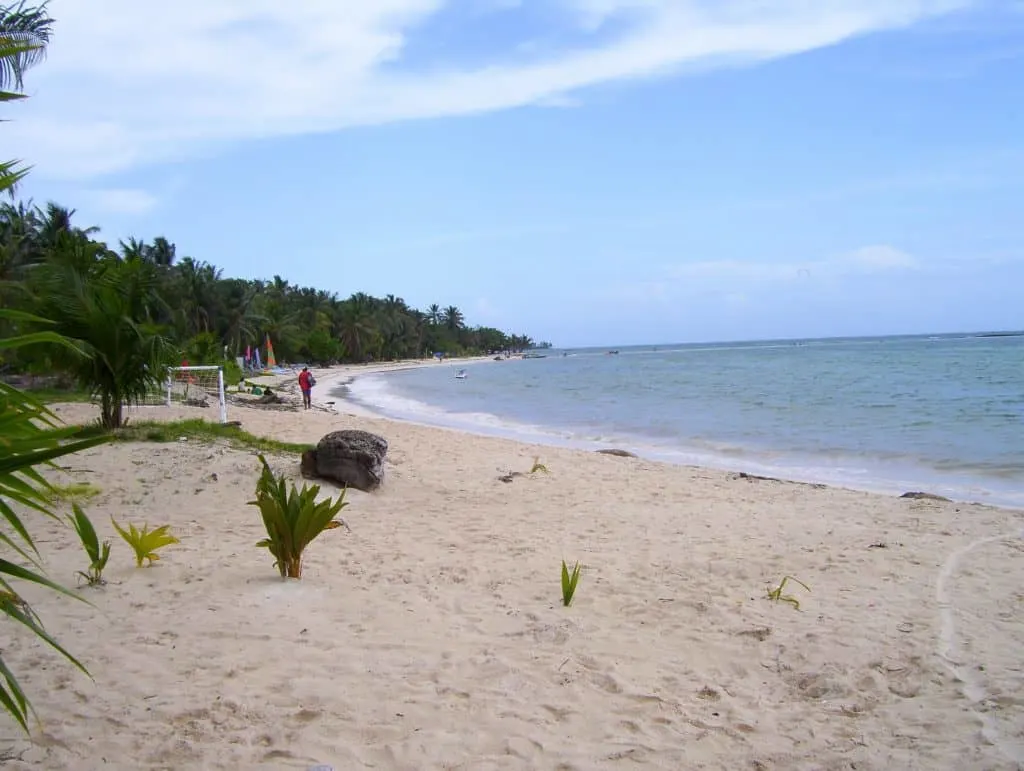
Playa Blanca is located 45 minutes outside of Cartagena in Isla Baru. Isla Baru is part of the Rosario Islands – a chain of islands in the Caribbean.
Playa Blanca has become more and more popular in the last few years especially since a bridge was built connecting it to the mainland. This makes it one of the most famous beaches in Cartagena.
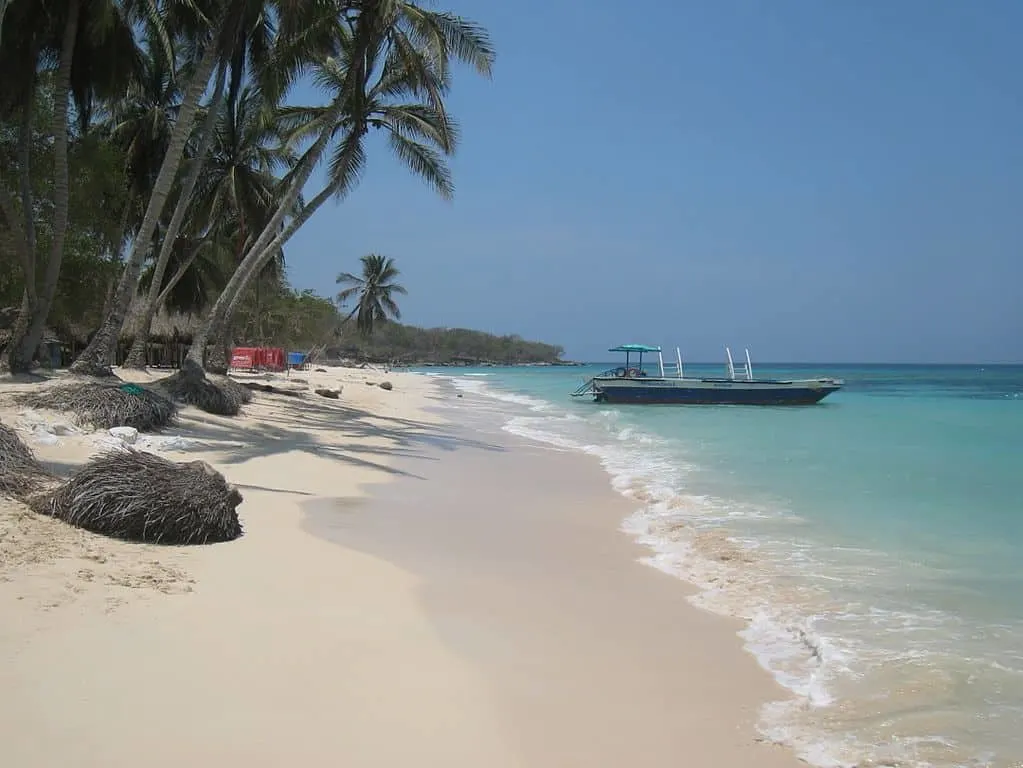
The popularity of the beach is not all good news. Yes, tourism in Colombia is on the rise but the infrastructure for rubbish and toilets are not there.
If you have time to visit Playa Blanca then I suggest going as early as possible to avoid the crowds. I do think a visit to Playa Blanca is worth it. Just remember to bring your sunscreen. It’s a great place to relax and enjoy the view. You may even want to rent a cabana for the day.
Do remember this is a popular tourist spot and there will be crowds and even touts selling trinkets and water. If you rent a cabana you will be farther away from the tours which are closer to the water. This is only a slight nuisance compared with the beauty of the beach. One of the Colombia fun facts is that it has over 50 islands in the Caribbean. The Rosario Islands and Playa Blanca are absolutely worth a trip when in Colombia.
From Cartagena: Rosario Islands Sailing Catamaran Excursion – Sail to the Rosario Islands and the San Bernardo Corals National Natural Park with snorkeling and time to relax. Snack and seafood lunch included. Click here for information and pricing.
Rosario Islands Private Speedboat Tour from Cartagena – View Tierra Bomba Island and then stop to tan at Cholón, with a tasty lunch at Hotel Gente de Mar. Click here for information and pricing.
Majagua Island Day Trip from Cartagena – A day at the beach on beautiful Majagua Island with a seafood lunch and time for biking and nature walks. Click here for information and pricing.
Playa Blanca full day trip from Cartagena – A full seven hours of sunbathing, swimming and relaxation with a seafood lunch included. Click here for information and pricing.
Visit a Bird Sanctuary – by Jo Castro, Lifestyle Fifty One of the most interesting ways to arrive in Cartagena is on a cruise ship. We arrived on the Sea Princess and had a really magical introduction to Colombia.

Close to the port we had access to a small bird park, actually an award-winning port oasis, and part of a1,000 square-metre garden. It showcases a sample of Colombia’s flora and fauna and is full of various types of splendidly colored Macaws, toucans, and electric pink flamingos. (There was also a troupe of entertaining Howler Monkeys, some iguanas and other regional animals.)
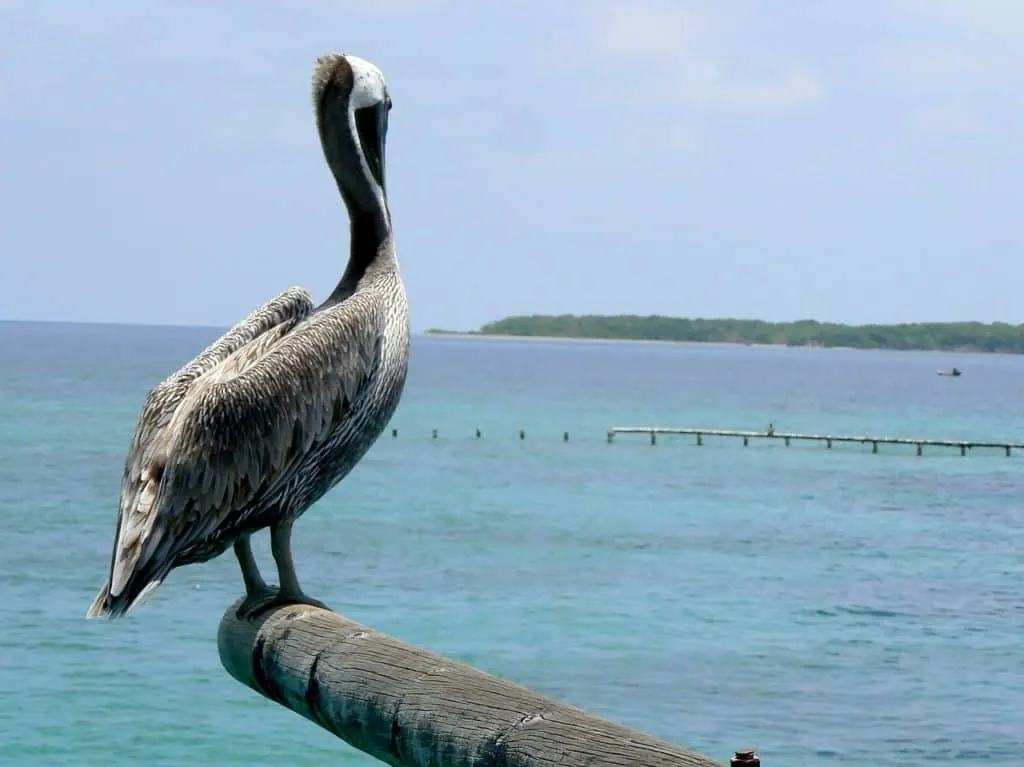
We found out that Colombia apparently has the greatest diversity of bird species in the world. If you’re looking for what to do in Cartagena and want to get a better glimpse of Colombia’s rich biodiversity you should consider a visit to the Aviario Nacional de Colombia bird sanctuary on the island of Baru, around a 45 minute coach ride from Cartagena. (Cruise ships sometimes offer this as a shore excursion).
The Baru Bird Sanctuary is one of the more unusual things to do in Cartagena. You can expect to see a wide variety of birds – around 190 species – ranging from macaws, peacocks exotic parrots and hummingbirds, to condors, and pink flamingos. Give yourself about 2-3 hours for the walking tour which takes you into different habitats, such as the Tropical Rainforest, Coastal Zone and Desert. Then cool off in the coffee shop with a nice cold drink afterwards.
See the sloths in Centennial Park – Lora Pope, Explore with Lora. Centennial Park is a gorgeous urban park in Cartagena’s old town. The park commemorates the 100th anniversary of the proclamation of Cartagena’s independence in 1811 from Spain. This is marked with the park entrance arch that features a crowned statue of an angel protecting a soldier.
Centennial Park was extensively renovated in 2013, and offers visitors a lovely green space to relax with plenty of trees, gardens, benches, and fountains. What I love about Centennial Park is all the wildlife that you can find there.
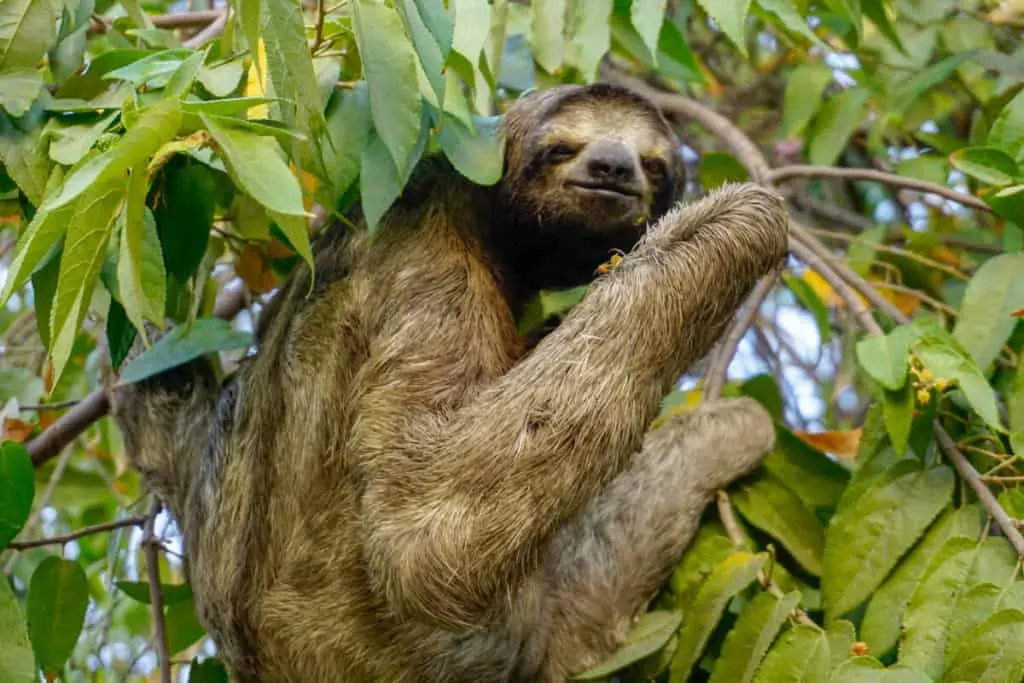
I wouldn’t have expected to see so much wildlife in the middle of the city, but as soon as I stepped foot in the park I noticed iguanas blending into the greenery. As I began to look around, I realized that the park was full of wildlife, from exotic birds to squirrels, and monkeys hanging from the trees.
Interact with Locals in a Variety of Eco-Experiences – La Boquilla is an authentic fishing village on the beach about 20 minutes from Cartagena. The attraction here is the mangrove eco-system and the traditional lifestyle where families of African descent make their living from fishing. Not to be confused with the high-rise, ritzy Miami Vice like neighborhood!
La Boquilla: 3-Hour Canoe Tour through the Manglars – This trip takes you into the heart of the essential mangrove eco-system’s hidden lagoons. Click here for more information and pricing.
Fishing with Locals in La Boquilla – Learn to fish with a line, nets and traps for a variety of species, and then attend a cooking class to turn your catch into a delicious meal with a local chef. Click here for more information and pricing.
Cartagena Coconut Workshop in La Boquilla – Learn to make a souvenir from coconuts in the traditional craft process done by the matriarchs of La Boquilla, followed by a refreshing ocean swim. Click here for more information and pricing.
Mud Volcano, Pink Sea and Indigenous Town Full-Day Trip from Cartagena – Enjoy a soothing volcanic mud bath, and visit points of interest in the town of Galerazamba, including the “pink sea” with English-speaking guide. Click here for more information and pricing.
Visit Tayrona National Park – Claire Sturzaker, Tales of a Backpacker. Tayrona National Park is a must-do on your places to visit in Cartagena and Colombia’s Caribbean Coast. The National Park covers an area of 150 km2 of land and 30km2 of ocean, and has lush forest, a beautiful coastline and an indigenous village to explore.
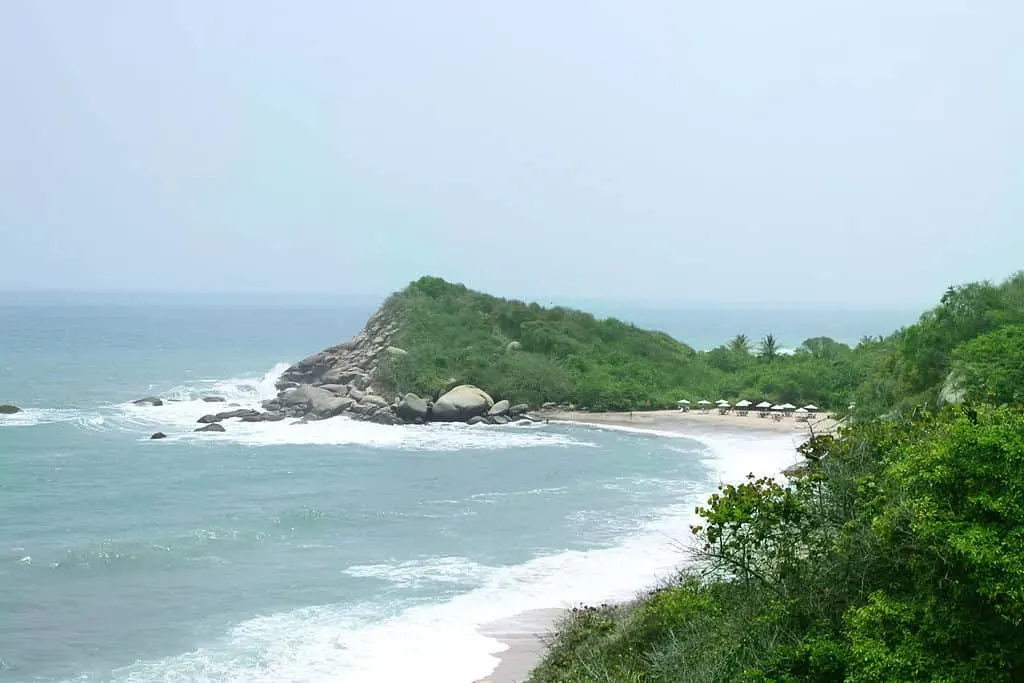
Tayrona National Park is about 5 hours’ drive from Cartagena, so it is best to spend the night somewhere closer to the park and visit the following day. It is possible to visit in a day, but if you have time to spend a night actually inside the national park, I’d highly recommend that.
There are frequent public buses or tourist shuttles which go from Cartagena to Santa Marta, the nearest big town, and you can take a bus, shuttle or taxi to the entrance of the park from there.
Tip: Cartagena to Tayrona National Park Transfer Service is a quick and convenient way to get to the park.
Once you are inside the park, you’ll need to hike through the forest for a couple of hours to reach the best beaches or hop on a horse taxi who will take you there for a reasonable fee. Some of the beaches have dangerous rip tides though so pay attention to the warning signs – La Piscina and Cabo San Juan del Guia are the most popular beaches for swimming.
As well as laze on the beaches you can also explore the jungle paths to hopefully spot endangered cotton-top tamarins and listen to the shrieks of the howler monkeys, or hike to the village of Pueblito.
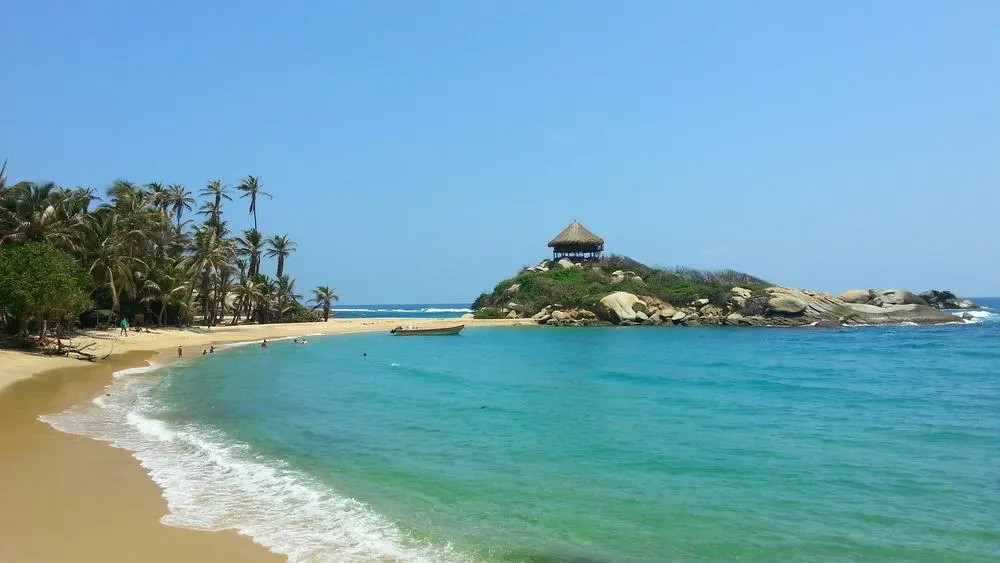
Celebrate Modern Culture in Cartagena
Live Life in the Plazas with Locals – One of the most charming aspects of daily life in Cartagena is that much of it is spent outside of one’s home in a plaza. This is one of the top things to do in Cartagena to gain an appreciation of the city’s unique lifestyle and ambience.
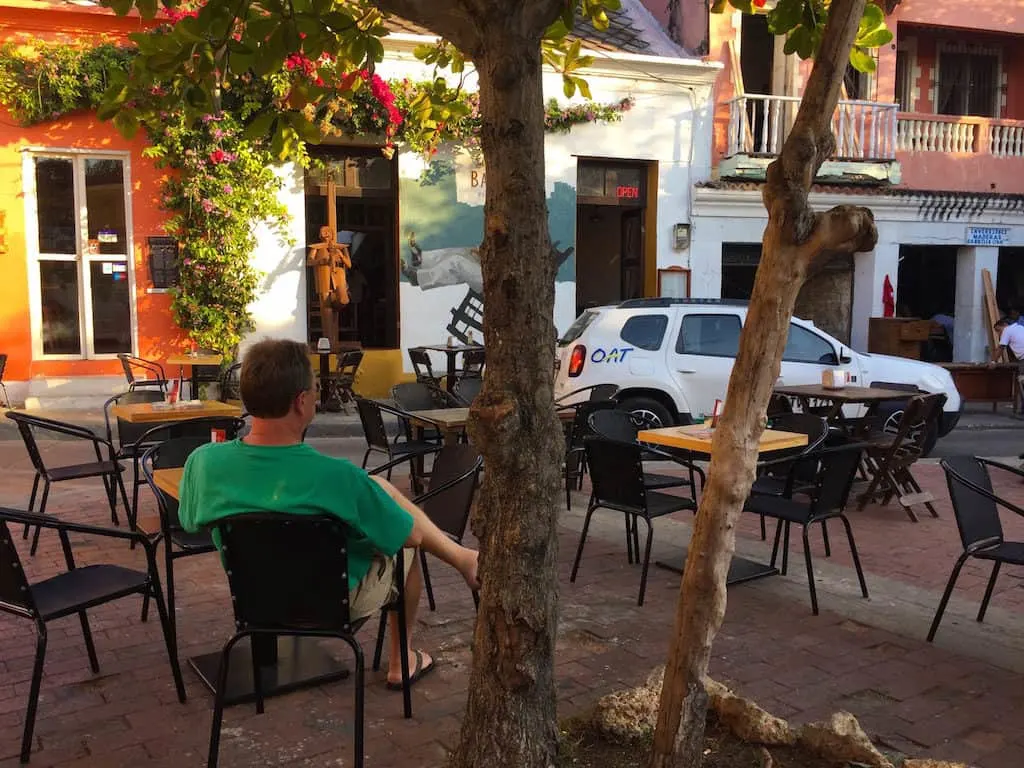
The little Plazuela de Pozo and its larger neighbor, the Plaza de La Trinidad (in the shadow of the beautiful Iglesia de La Trinidad) grounded our part of the larger Getsemaní neighborhood.

As the afternoon waned and the heat of the day dissipated, these local squares began to fill with neighbors, street musicians, vendors and food carts.

The plazas provided entertainment for all ages, whether it was a friendly conversation at a table or bench, an impromptu game of futbol, or a shy flirtation with a special someone. We loved strolling over and being part of the scene as night fell.
Nobel Prize winner Gabriel Garcia Márquez, affectionately known as “Gabo,” was born and raised on Colombia’s Caribbean Coast. He studied law at the University of Cartagena and wrote for El Universal newspaper here. Later, he popularized the magic realism literary style, along with authors such as Isabel Allende and Salman Rushdie. Upon his death in 2014, President Juan Manuel Santos declared Garcia “the greatest Colombian who ever lived.”
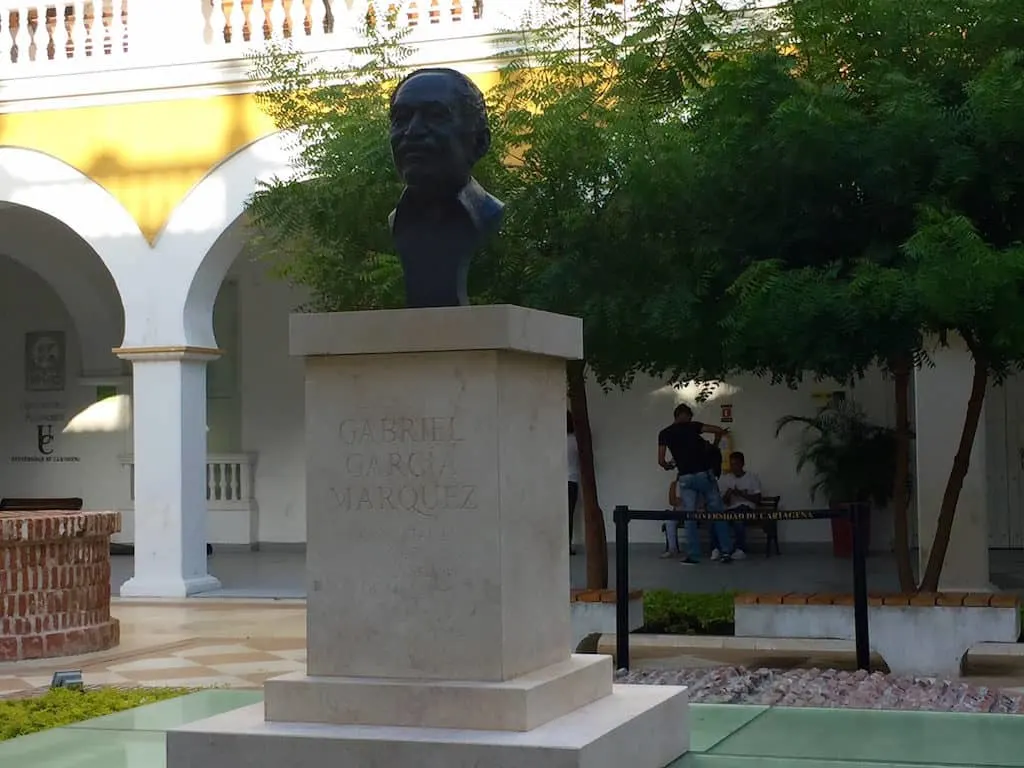
Visit the Teatro Heredia – Designed and built in the early 20th century on the site of a church dating back to 1625, the Teatro Heredia – also known as the Adolfo Mejia Theatre – was restored and reopened in 1998. Now it is one of the foremost places to visit in Cartagena for lovers of music and the arts.
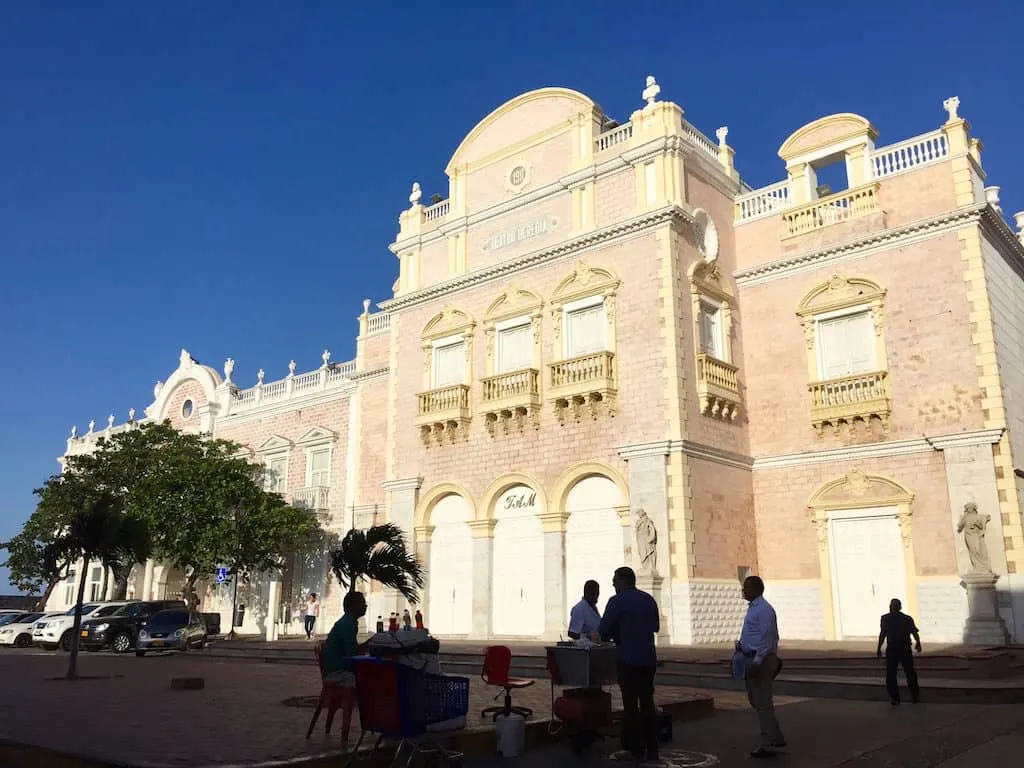
Architecturally significant, the theater’s exterior is a meld of Italianate and Caribbean style, while its interior is distinguished by Carrera marble stairways, lacy latticework, and 22 carat gold. The painted ceiling and curtain murals depict arts, sciences and local motifs.
Two unique Cartagena Museums will tempt lovers of pre-Colombian art, precious metal and jewels: the Jewelry and Emerald Museum and the Gold Museum (Museo del Oro Zenu).
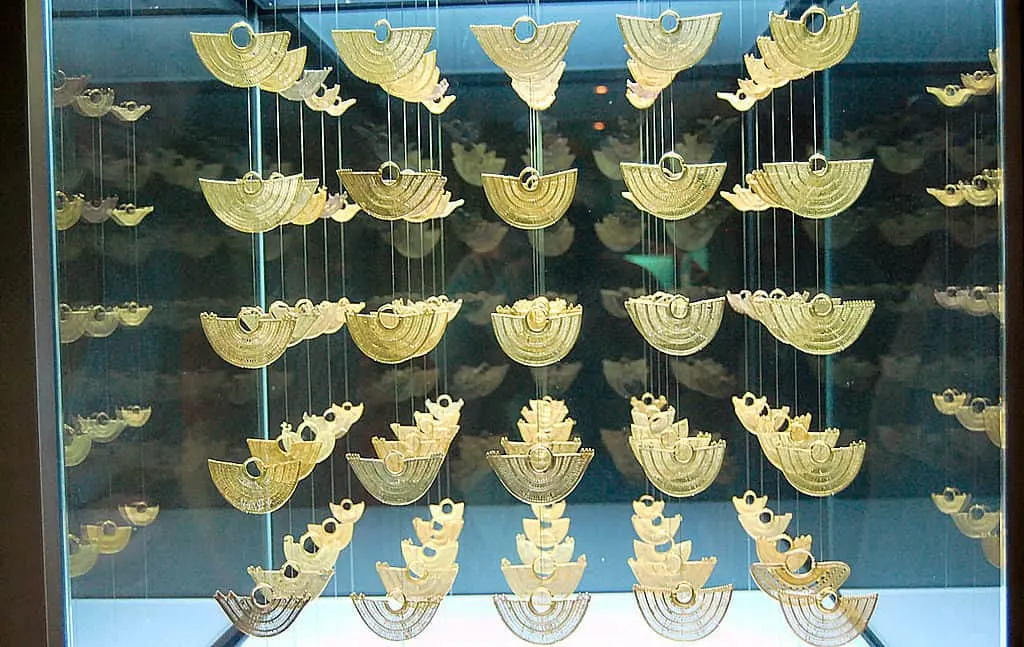
Dance the salsa at Cafe Havana – Lose yourself in one of the stalwarts of Cartagena nightlife: salsa dancing. While Colombians and Cubans alike claim the sensuous salsa as their own, you can avoid the controversy altogether at Cafe Havana. Kick up your heels at this atmospheric watering hole in Getsemaní to the energetic strains of live musicians, and enjoy a menu of Cuban fare. The action starts after 9PM and goes until 4AM.
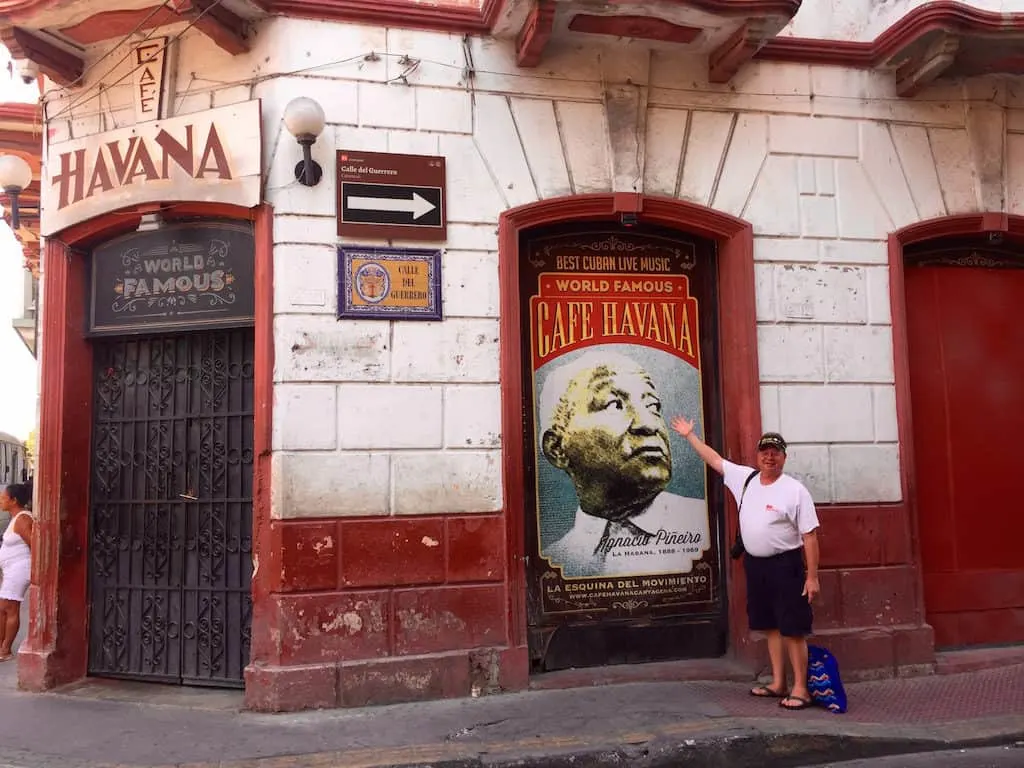
Cartagena bars run the gamut from old school colonial style rum bars to beach hangouts, with everything in between. Craft cocktails and beers with complementary small plates or entire menus will ply your taste buds. The music is invariably lively and upbeat for dancing and socializing.
For information on a Salsa Bar-Hopping Night Tour, click here.
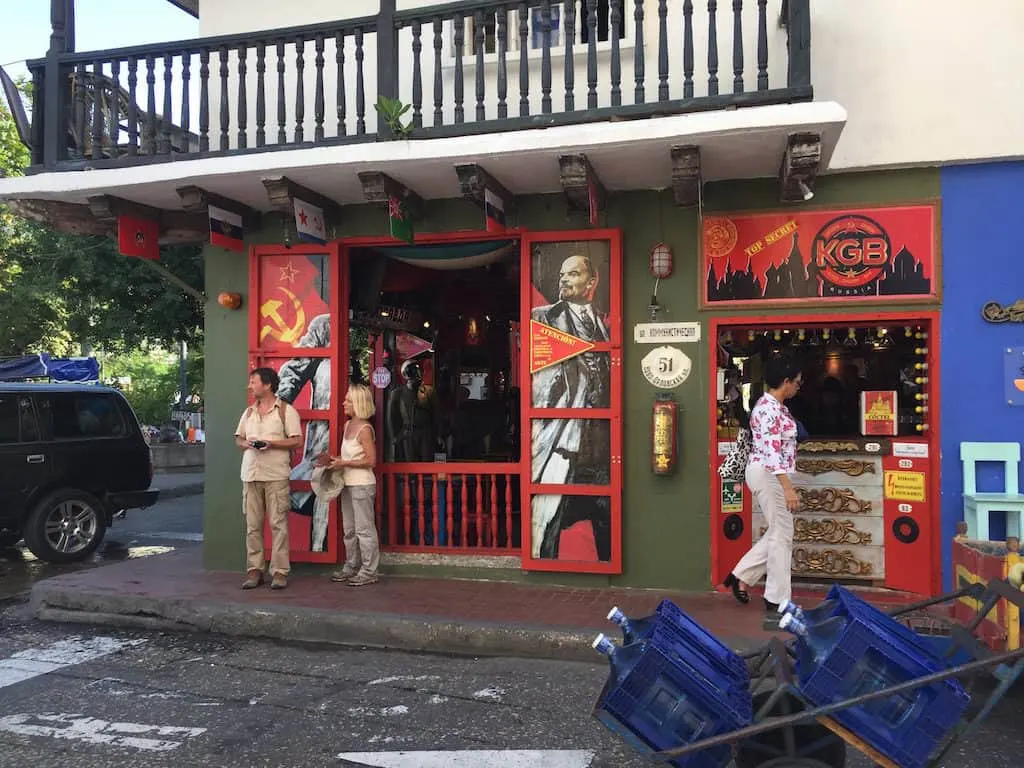
Check out this list of the best bars in Cartagena where you can get your drink and dance on.
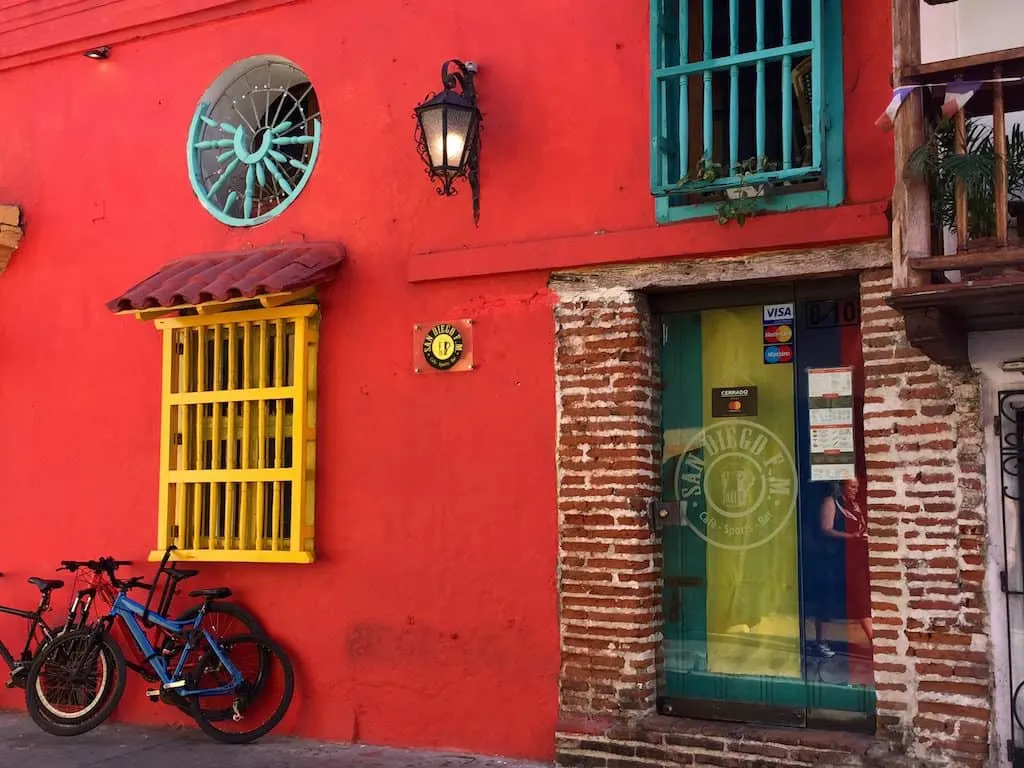
Explore Bazurto Market – by Daniel James, Layer Culture. With so many things to do in Cartagena and with all the events happening within the old square, it’s easy to get stuck walking around the walled city. But what if you’d like to do something off the beaten track in Cartagena? Something that when you go, you won’t be slowed down by other tourists or persistent locals trying to sell you fancy objects. You could try the Bazurto Market.
Some tourists are hesitant to go so far out, but if you’d like the idea of doing some cultural travel whilst meeting locals and getting to know the less touristy side of Cartagena; I can assure you that you won’t be disappointed here.
For information on a 4 hour Guided Bazurto Market tour, click here.
The market is fairly big, so depending on which side you enter, you’ll encounter either food, clothes, electronics or one of the other many random objects. Do you like to travel with a camera? This place is a photographers paradise. You’ll be sure to get some of those obscure shots that’ll make you glad that you visited.
One word of warning though, the smell of fish is very intense at one side of the market, but try your best not to let it put you off. The real gem is once you arrive inside the market, I recommend heading for the fruit and vegetable section.
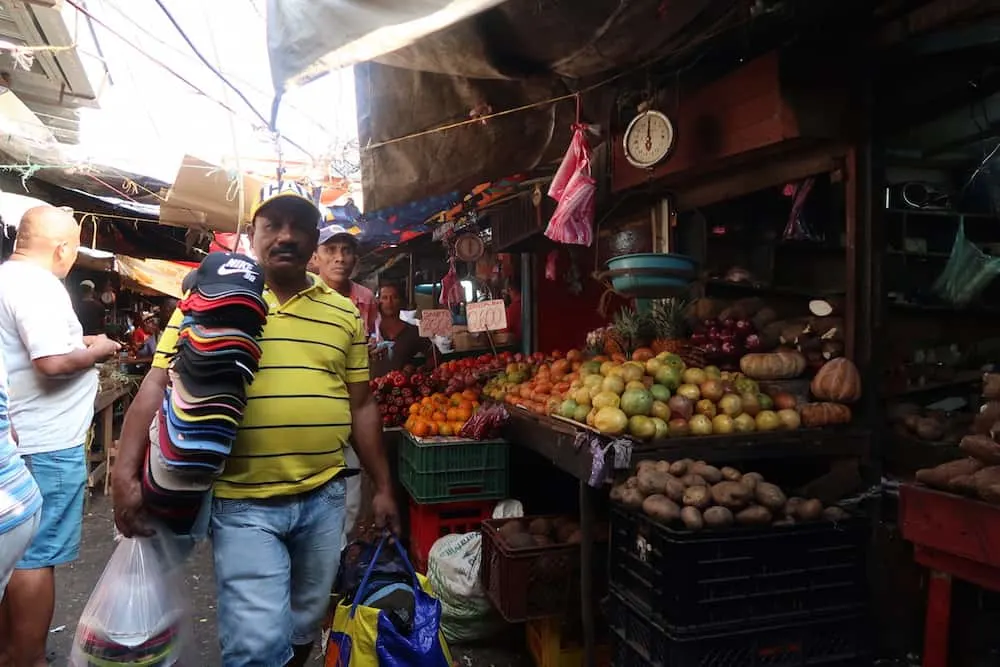
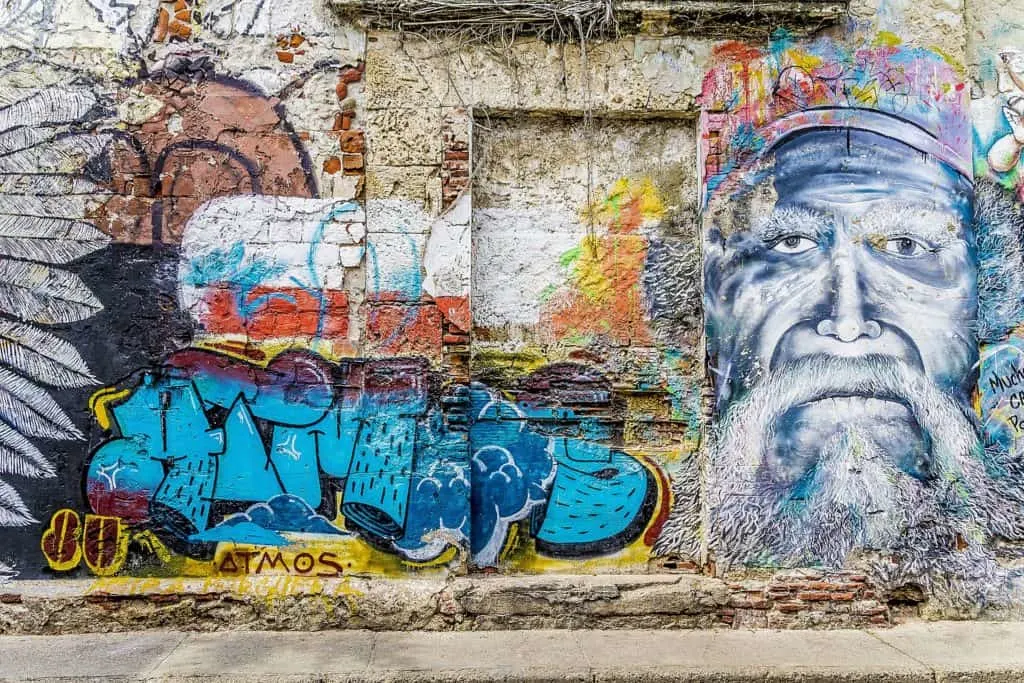

On the good side, Getsemaní has become much safer and now has a nice lively and thriving atmosphere. There are many new businesses flourishing in the area and this attracts more visitors.
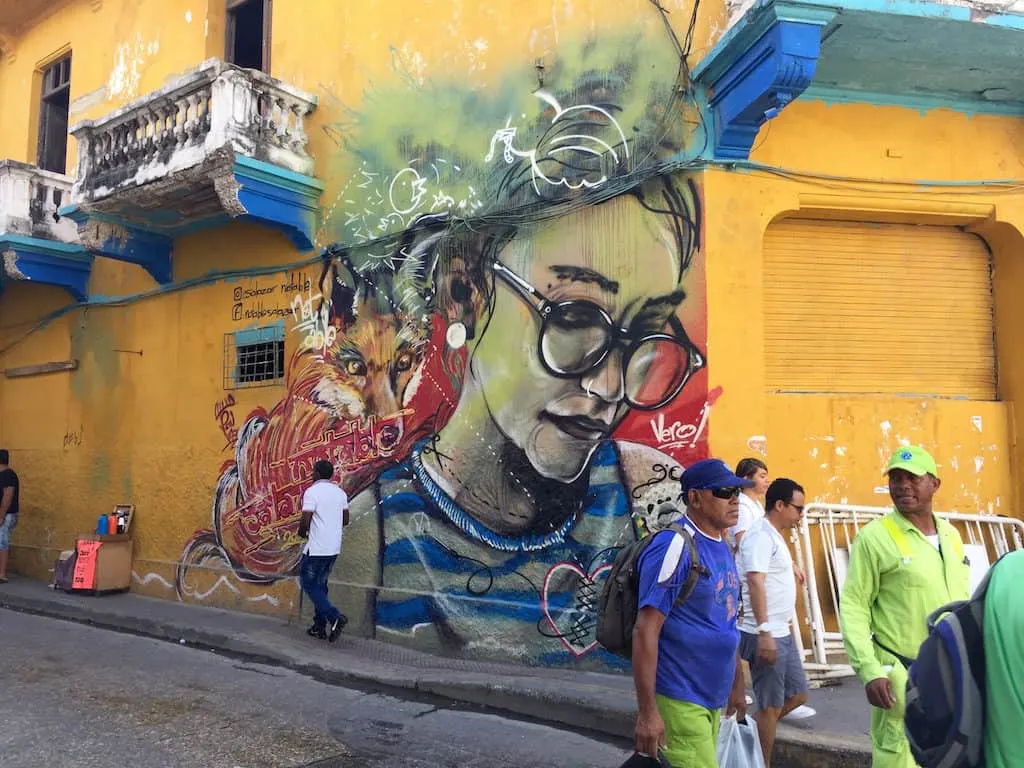
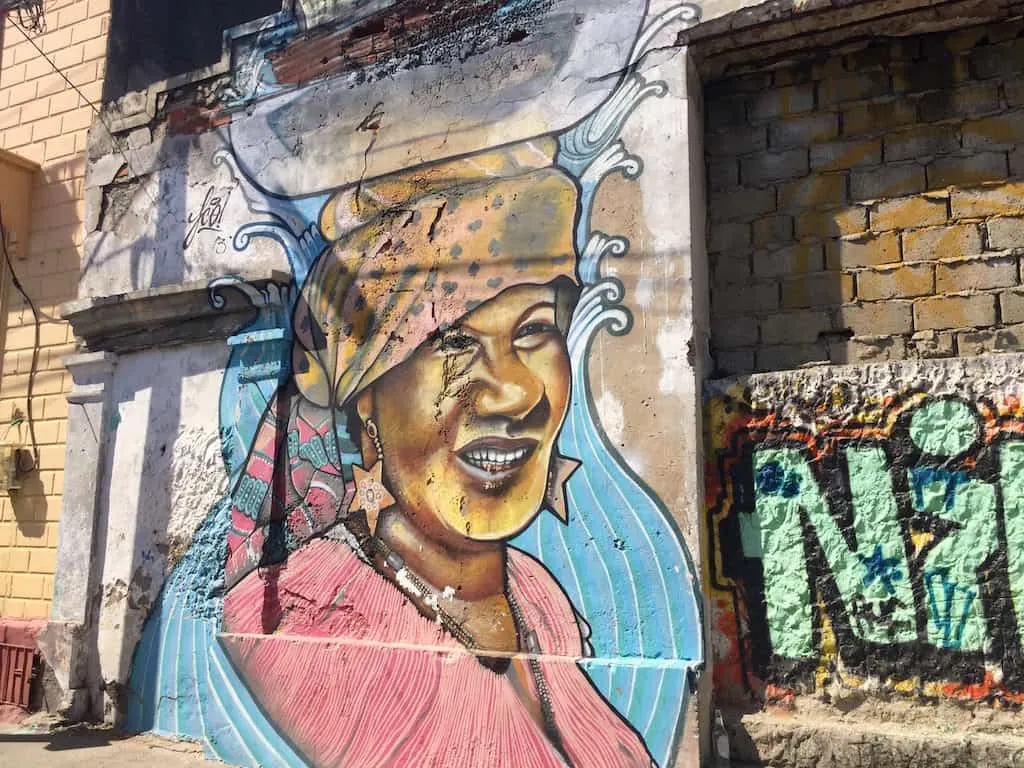
A lot of the colorful murals that you can see in Getsemaní are inspired by the struggles that this area has faced throughout its history, from the colonial times and the fight for Independence to the modern gentrification process.

The best areas to see street art in Cartagena are around Plaza de la Trinidad and Calle de la Sierpe (also known as Calle 29). Take time to wander around and you’ll find some really great works by both international and local urban artists, such as Fin DAC, Pez, Yurika MDC, and Ceroker.
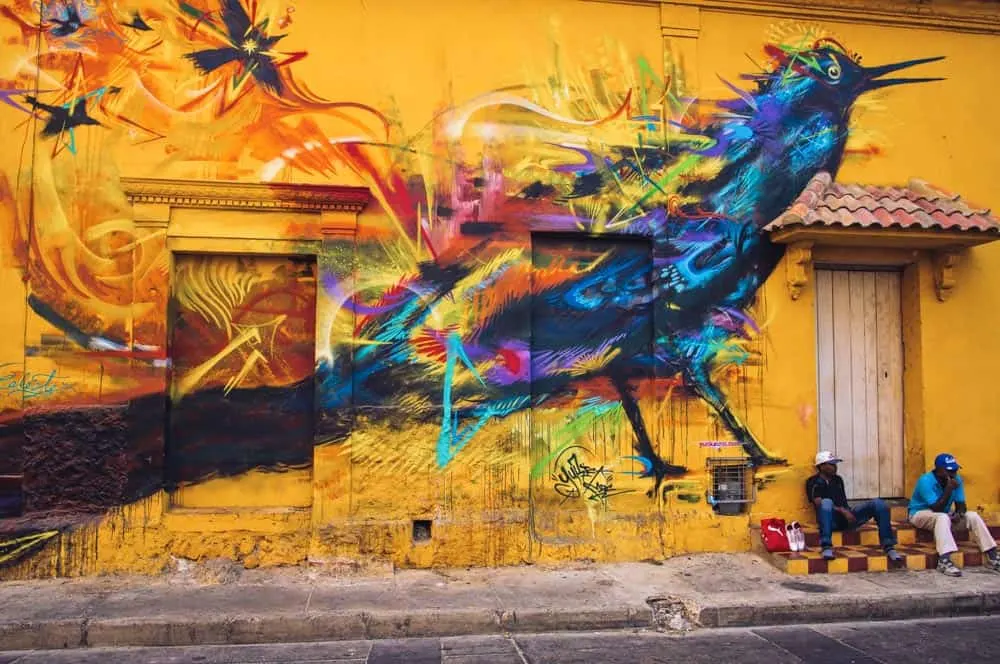
Have Fun with the Sculptures of Edgardo Carmona – Colombian sculptor Carmona has captured the whimsical elements of everyday life in rusted metal installations that appear around the city.

Shaping sheet metal combined with found objects, Carmona brings a smile with these witty depictions of Cartageneros.
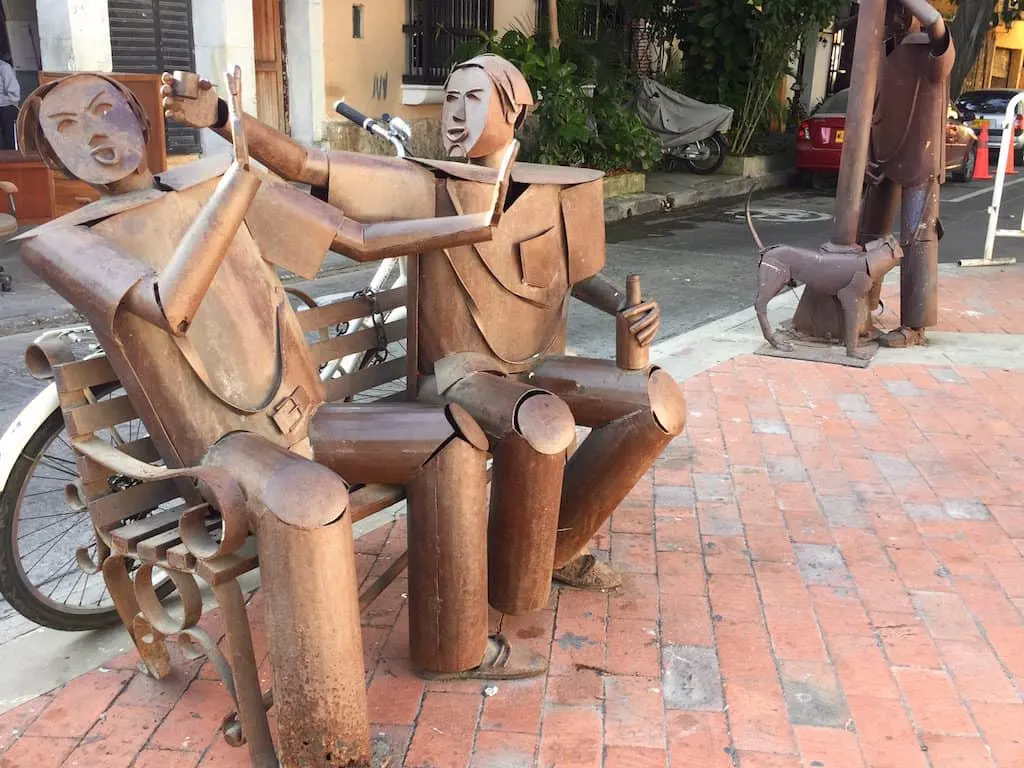
Pose with La Gordita Gertrudis – The unmistakeable Fernando Botero is known for his exaggerated depictions of humans in paint and form.
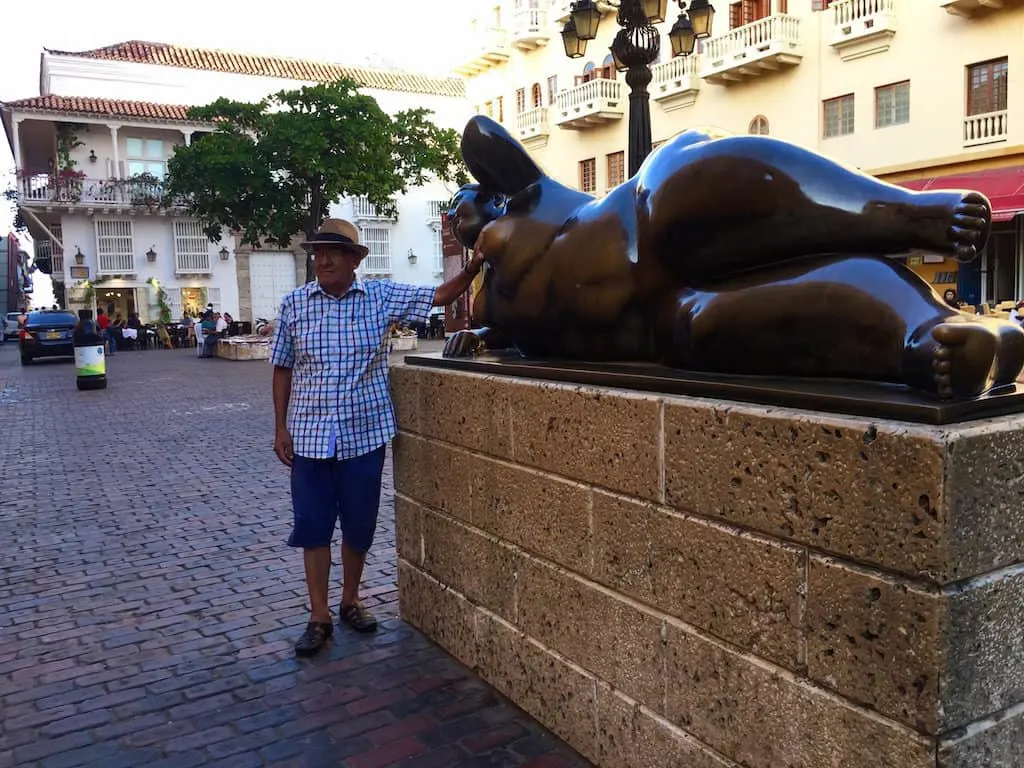
This has to be one of the top 10 things to do in Cartagena. Visitors love to pose with The Little Fat Gertrude and certain parts of her anatomy are shiny from their touch. You’ll find her outside the Church of San Pedro Claver in Old Town.
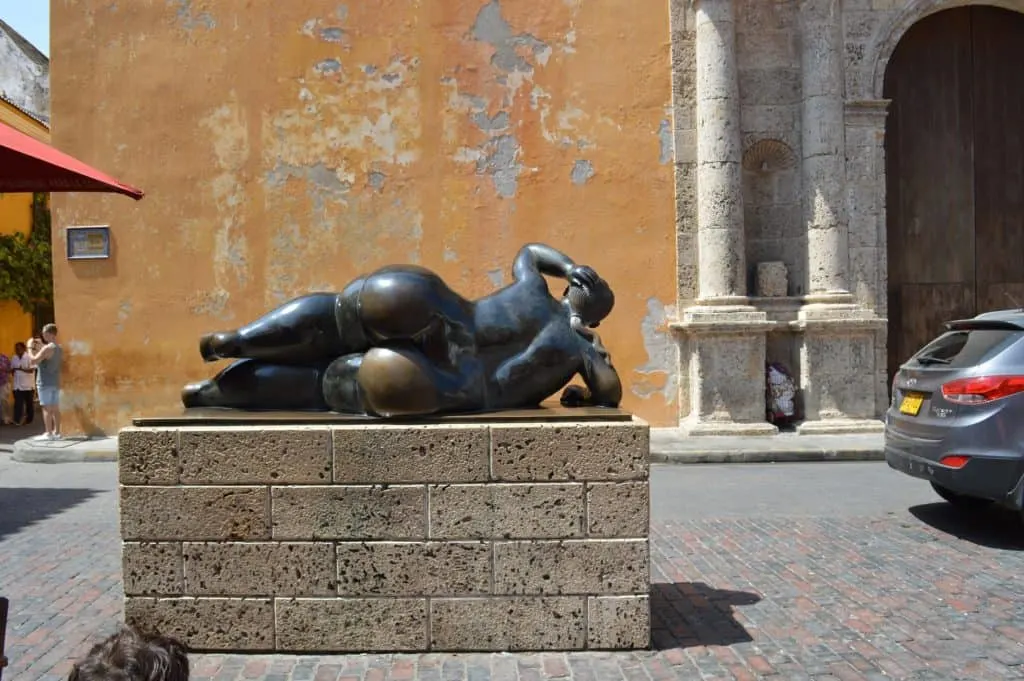
Seek Out Sensational Cartagena Street Food at Every Time of Day – One thing you must do in Cartagena is indulge in its street food.
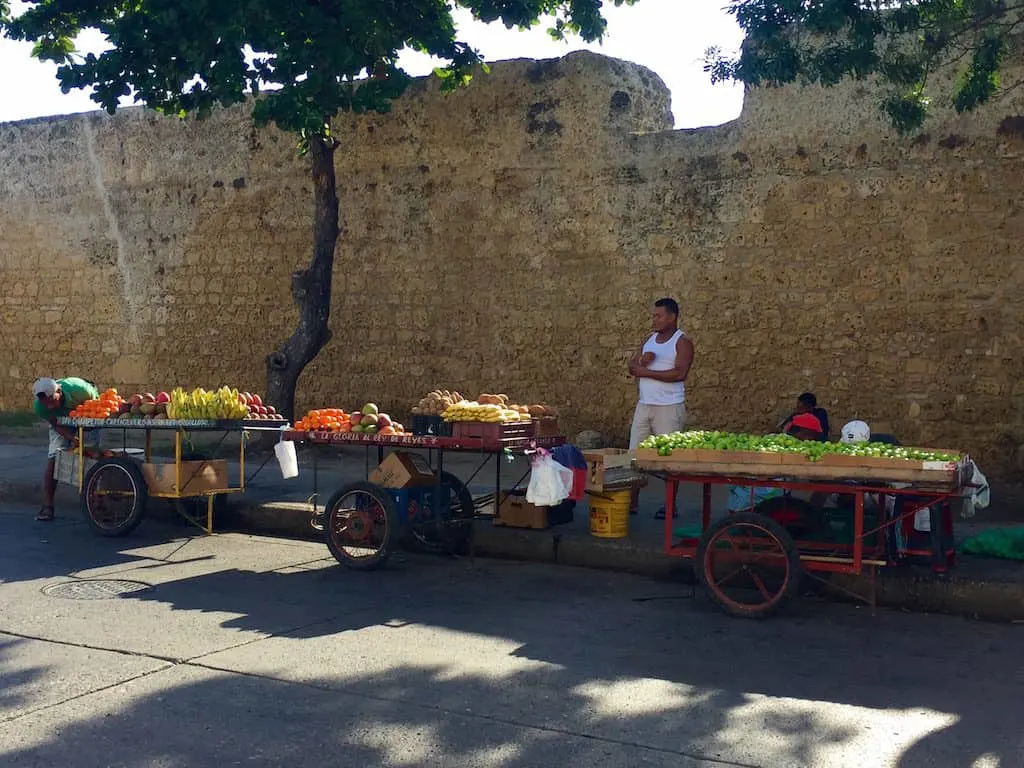
Vendors abound and you could easily eat every meal on the street during your stay. Food is fresh, plentiful and inexpensive.
For breakfast, several pieces of fruit, a couple of empanada like pockets with meat or cheese, and delicious Colombian coffee set us back less than $5 for two people.

Try the local country-style soft and somewhat salty cheese, served from an fresh enormous block carried in to the city each day.

Or chow down on “Plato Tipico” – a paella-like dish dressed with shellfish.
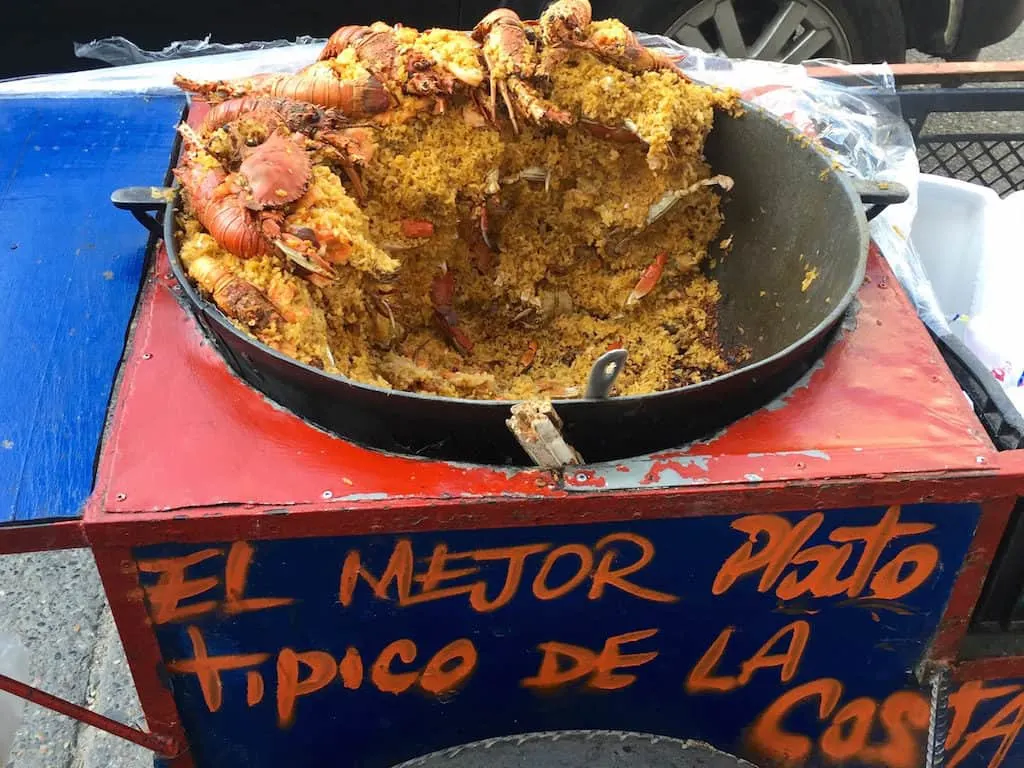
At night, the smoke of street food permeates the plazas. Look for plates made up with spicy chorizo-style sausages, meat and vegetable kebobs and roasted corn.
For information on a Cartagena Street Food Tour, click here.
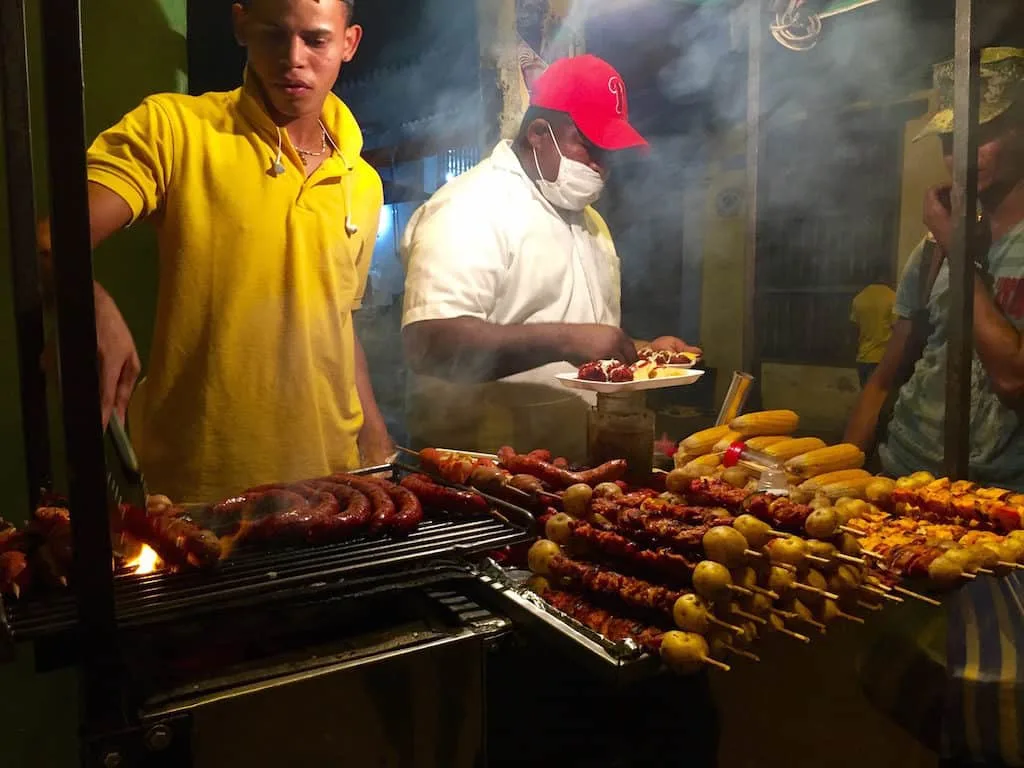
Top Things to Do in Cartagena, Colombia: Savor the Delicious Caribbean Flavors from the Best Restaurants
Eating Your Way Through Cartagena – by Andrew John Virtue Dobson, Dobbernationloves
Colombian cuisine includes the cooking traditions and practices of Colombia’s Caribbean shoreline, Pacific coast, mountains, jungle and ranchlands. Menu offerings vary regionally and are influenced by the indigenous Chibcha, Spanish, African, Arab and Asian cultures that have left an impression on kitchens from Cali to Cartagena.
If you’re visiting Cartagena you’ll have the opportunity to enjoy hearty Colombian national dishes as well as tropical creations unique to the Caribbean coast. The cuisine in Cartagena is seriously sublime!
Skip across Cartagena’s cobblestone streets and you’ll find street vendors selling crispy arepa, slices of tropical fruit and thirst quenching limonada de coco.
If you’re looking to enjoy a traditional Colombian feast at a restaurant head to La Cocina de Pepina. The quaint family-run restaurant is always bustling with locals and specializes in serving classic Colombian fare.

If you’re looking for a more fine dining experience, make a reservation at Movich Hotel Cartagena. The luxury boutique hotel’s Alyzia Restaurant offers a romantic dining room with a menu inspired by Colombia and Mediterranean flavours. The chef’s steaming bowl of parsley risotto is topped with shrimp ceviche. A citrus and seafood lovers perfect mouthful. Be sure to try Alyzia’s namesake cocktail, a refreshing tipple featuring vodka, lemon and indigenous corozo juice.
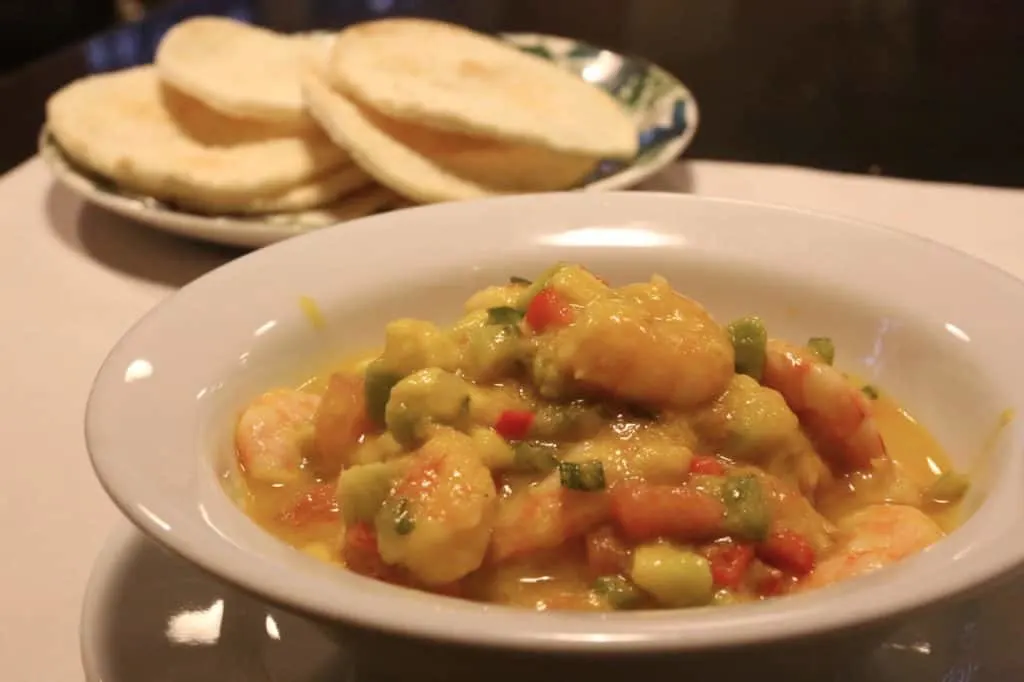
Fine Dining at Carmen Restaurant – by Stefan Arestis, Nomadic Boys. Cartagena is beautiful, ideal for romantic and special occasions, with many excellent fine dining restaurants. We came here to celebrate Sebastien’s birthday and stayed in the charming old town.
For his birthday dinner, we decided to pick one of the finest fine dining restaurants. Asking around fellow travelers and locals, most people recommended Carmen as the best restaurant in Cartagena. We were not disappointed. It’s an impressive restaurant, with a warm, friendly atmosphere, with a modern and elegant décor.
This was also a very important occasion, because this was the moment I chose to propose to Sebastien – right at the end of the meal after the birthday cake. The food was exquisite particularly the seafood dishes. We went for the 10 course taster menu, each paired with a different wine. Most of the dishes were surprise dishes, carefully created for us after a discussion with our waitress as to what sort of things we do/don’t like.
Some of our favorite dishes were the plantain encrusted snapper with a fermented honey sauce and a yummy green sponge cake served with strawberry ice cream and a pomegranate-like sauce. The service was impeccable. The staff were super friendly and helpful, which made it even more special. And of course, Sebastien said “Yes!”
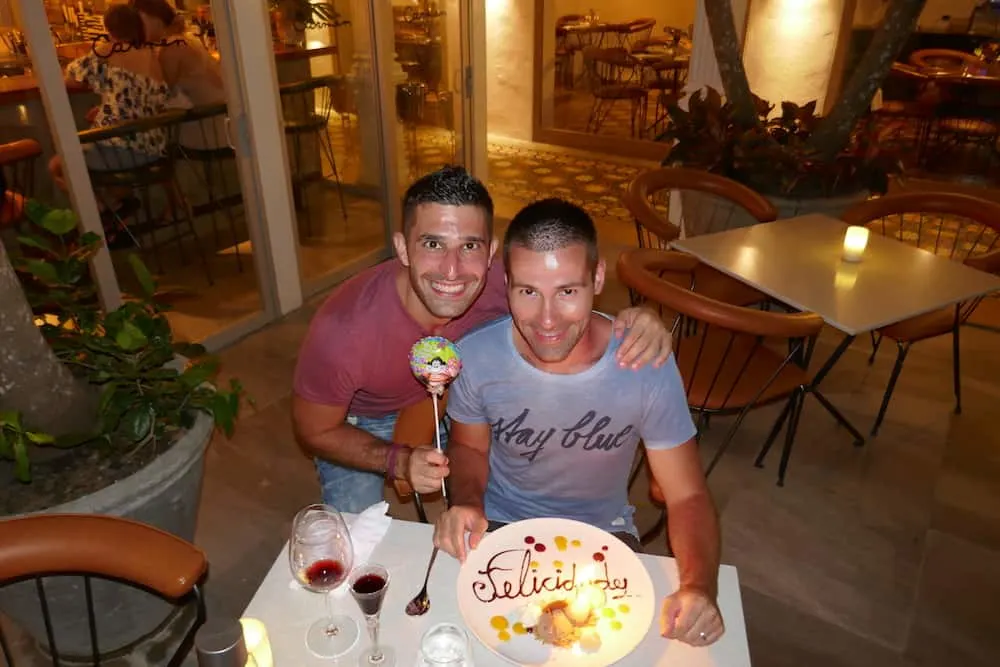
Eat dinner at Interno, a women’s prison in Cartagena – by Sarah Carter, ASocialNomad. You’ll be spoiled for choice as to finding the best places to eat in Cartagena – the fusion of Colombian and Caribbean food is an interesting flavor that you won’t find elsewhere in the country.
It’s here too that you’ll find one of the most unique places to eat in the world. This is a special place to eat dinner – inside a women’s prison! Restaurante Interno is set up as an NGO inside the San Diego women’s prison of Cartagena. By eating dinner here you’ll be helping to provide a second chance for the women interred here.
The restaurant is staffed by inmates who are taking the opportunity to reintegrate socially and build a skill set for their futures. Funds raised go towards improving the conditions of those serving their sentence here.
Book via email phone or WhatsApp – the restaurant is only open for dinner and we recommend you book when you arrive in Cartagena. There is a set menú and your meal cost includes a starter, entrée and dessert. Juice is included in meal, although you can also buy wine to celebrate your visit. Restaurante Interno: Cárcel de Mujeres de San Diego, calle 39, Barrio San Diego, Cartagena. Reservations: +57 (310) 2 600 134 or restauranteinterno at gmail dot com.
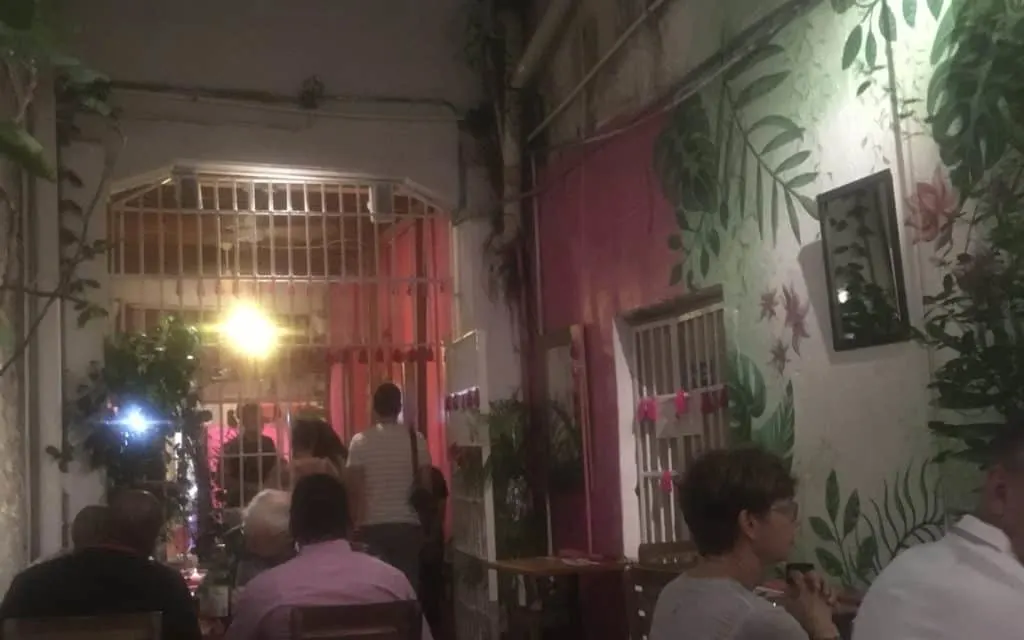
Our Picks for Best Restaurants in Cartagena
Chachara – Occupying a house which was once the home of famed Brazilian street artist Bel Borba, as well as renowned Colombian salsa musician Juan Carlos Coronel, Chachara presents a well-rounded menu of Caribbean specialties and traditional favorites. Something for everyone here. Check out the charmingly naive tilework on the facade; this is Borba’s decorative work, uncovered during the remodel.
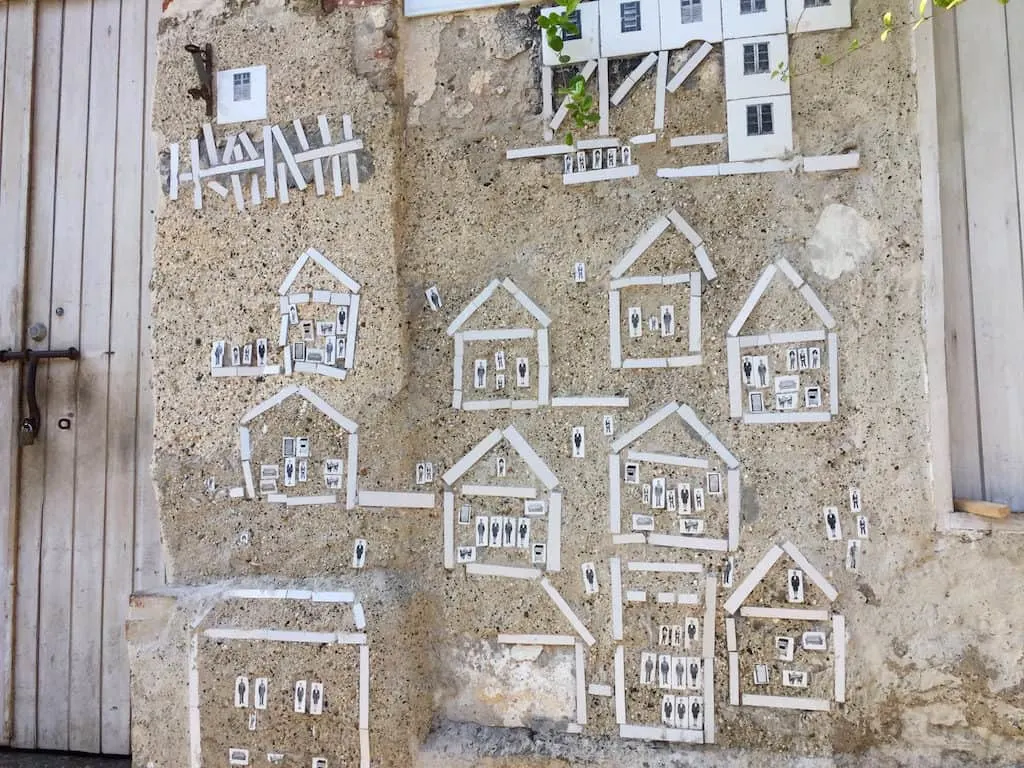
Oh La La – French dishes are infused with a Caribbean overtone which renders traditional Gallic flavors with local personality. Lunch is just as good as dinner, and don’t miss the desserts.
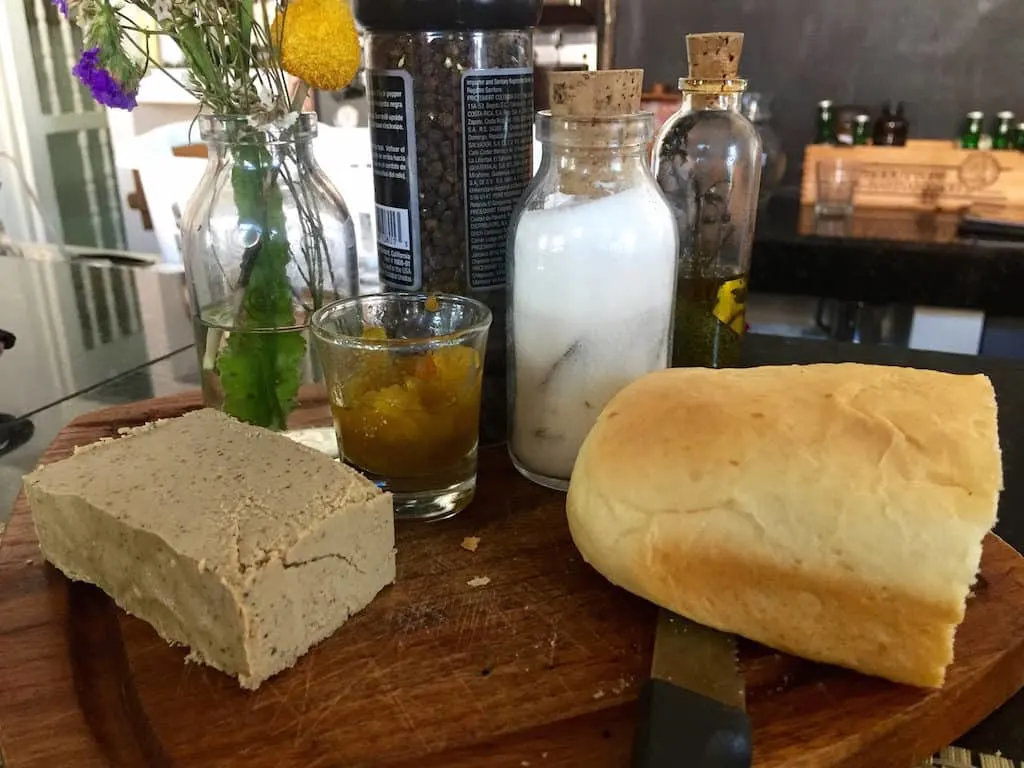
El Gato Negro – Best breakfast in Cartagena if your idea of perfection is sharing it in a shady courtyard archway with several cats and a friendly pooch. Enjoy the complimentary pineapple juice. Only open until 2pm.
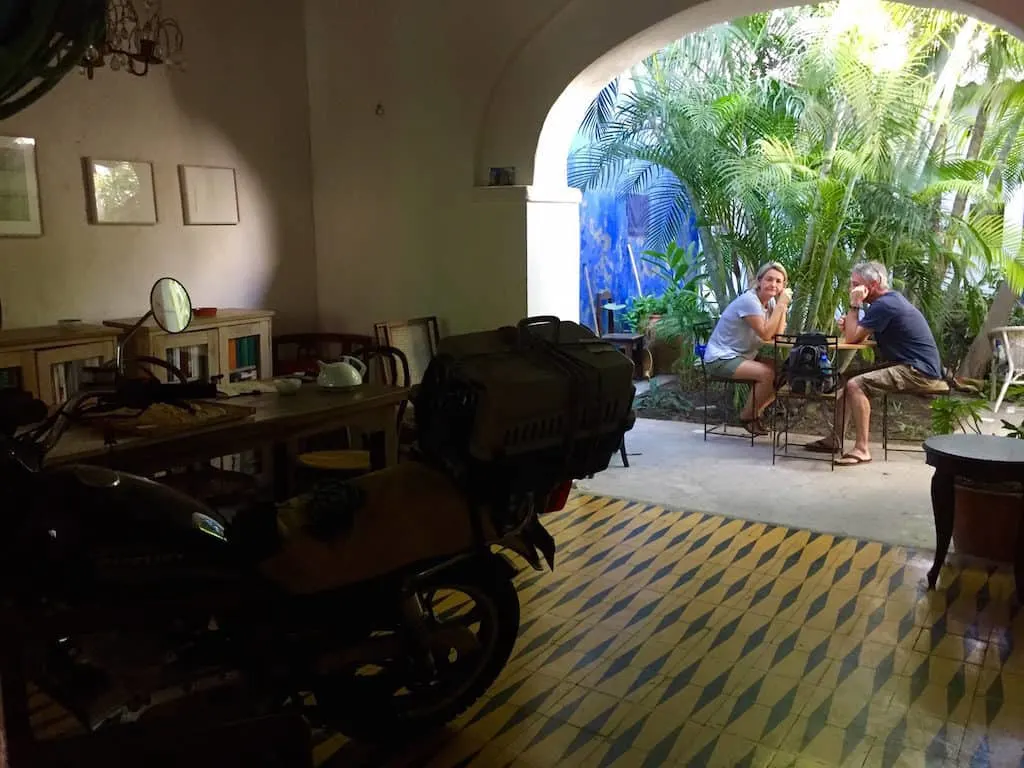
Castellana Df – Sometimes you want to linger over a delicious breakfast at an air-conditioned table by the window and watch the world go by. This is where you do that.
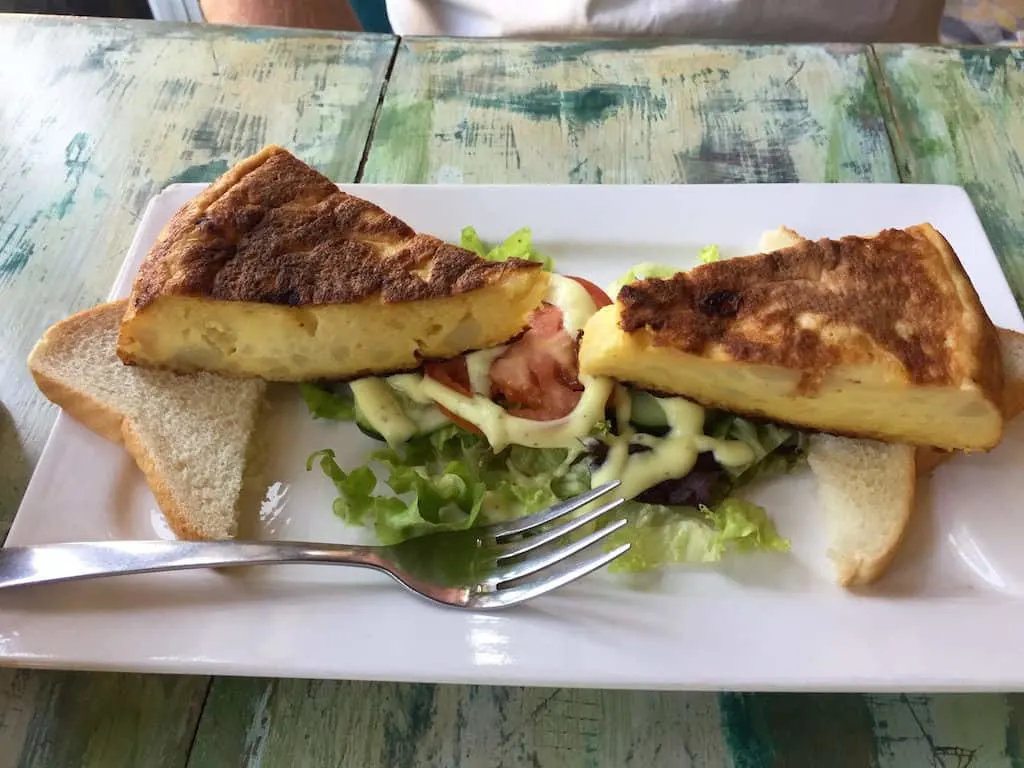
Beer and Laundry – We’d be remiss if we didn’t mention this outstanding business concept. Bring your laundry in and they’ll wash, dry and fold it for you while you enjoy a frosty cold one and pizza by the slice or the pie. So civilized, you’ll weep.
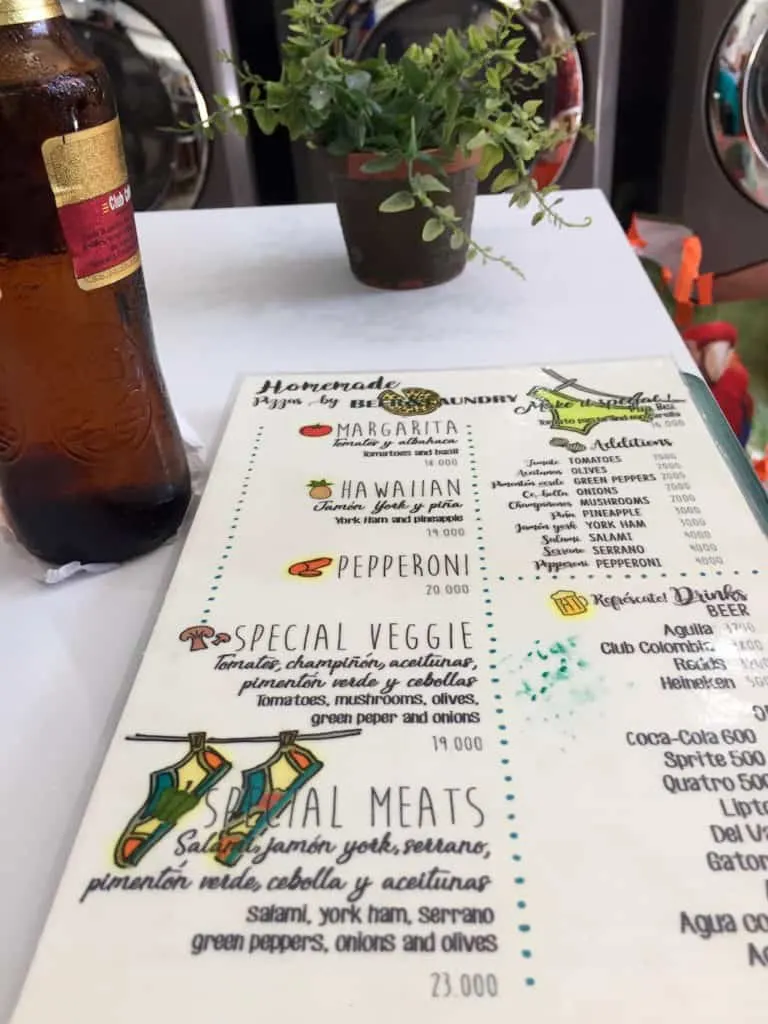
Pinnable Images:
Pin these images in your Pinterest to remind you of the the top things to do in Cartagena.
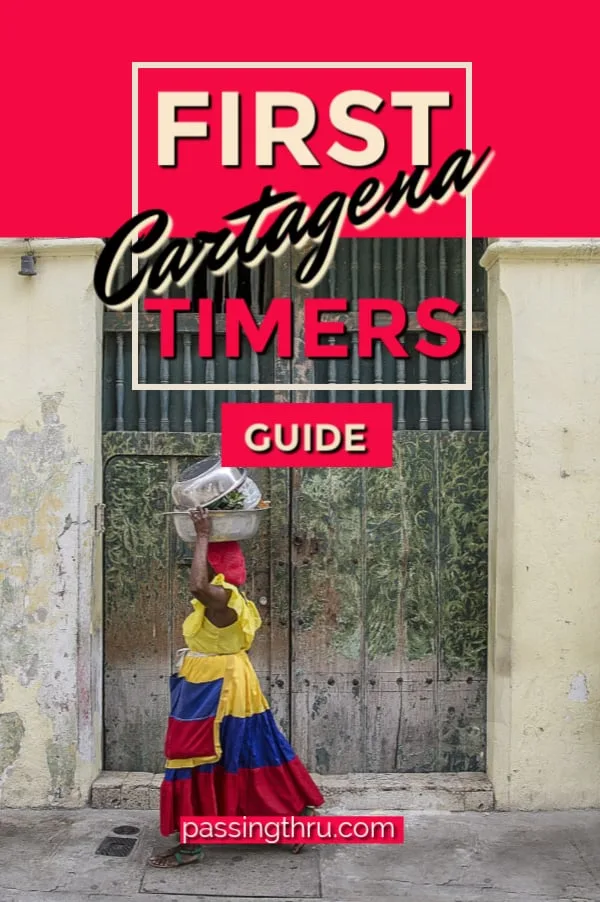

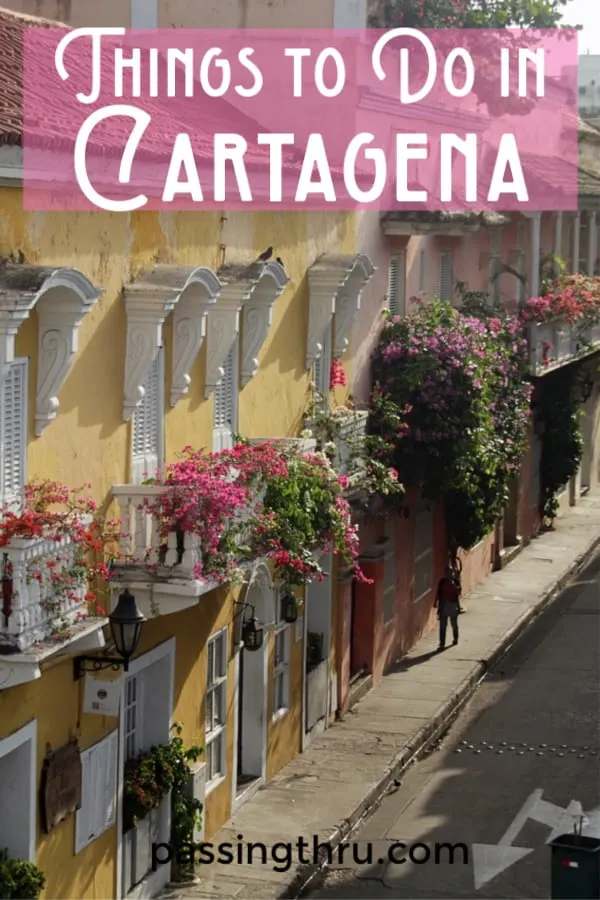
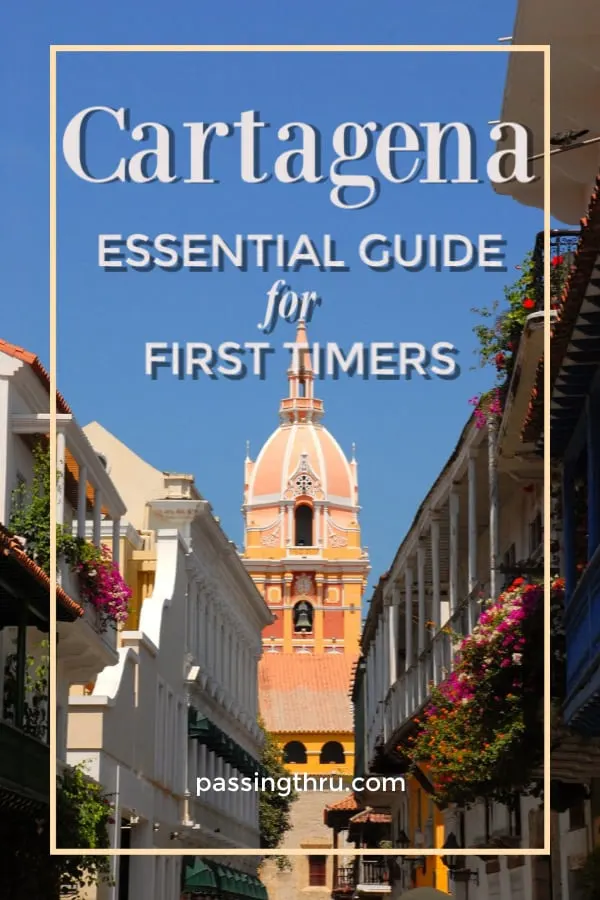
Tips for Trip Success
Book Your Flight
Find an inexpensive flight by using Kayak, a favorite of ours because it regularly returns less expensive flight options from a variety of airlines.
Book Your Hotel or Special Accommodation
We are big fans of Booking.com. We like their review system and photos. If we want to see more reviews and additional booking options, we go to Expedia.
You Need Travel Insurance!
Good travel insurance means having total peace of mind. Travel insurance protects you when your medical insurance often will not and better than what you get from your credit card. It will provide comprehensive coverage should you need medical treatment or return to the United States, compensation for trip interruption, baggage loss, and other situations.Find the Perfect Insurance Plan for Your Trip
PassingThru is a participant in the Amazon Services LLC Associates Program. As an Amazon Associate I earn from qualifying purchases.
To view PassingThru’s privacy policy, click here.

umrahpackagedubai
Monday 10th of July 2023
great post please keep me posted
Johanna Castro
Tuesday 19th of March 2019
A fabulous taster of Cartagena, with enough advice here to keep anyone busy and occupied. I think it gives an in depth introduction to this beautiful city - offering quests from which to catapault into a more in depth discovery of Colombian culture and scenery. (Thanks for including my suggestion too.)